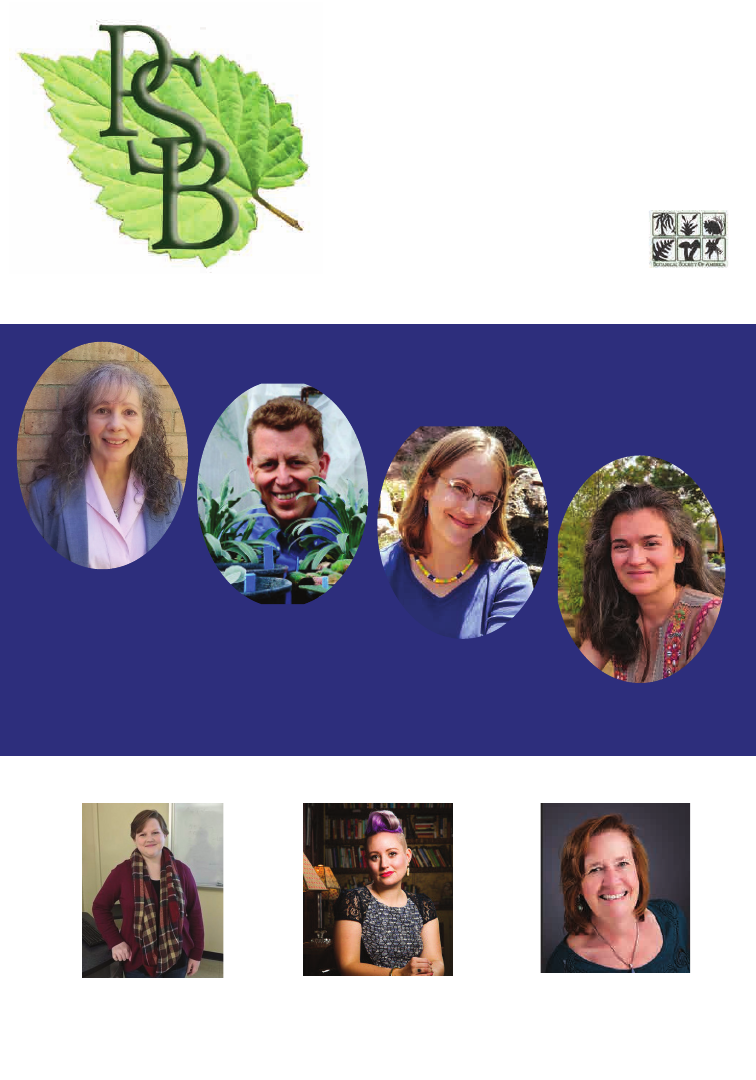
IN THIS ISSUE...
SUMMER 2021 VOLUME 67 NUMBER 2
PLANT SCIENCE
BULLETIN
A PUBLICATION OF THE BOTANICAL SOCIETY OF AMERICA
Cole Imperi explores the emerging
field of thanabotany... p. 101
Wanda Lovan, BSA Director of
Finance & Administration,
Retires... Inside Back Cover
Kate Parsley on new ways to combat
“plant awareness disparity”.....p. 94
Registration Now Open!
Meet the Newest Members of the BSA Board!
Vivian Negron-Ortiz
J. Chris Pires
Rachel Jabaily
Ioana Anghel
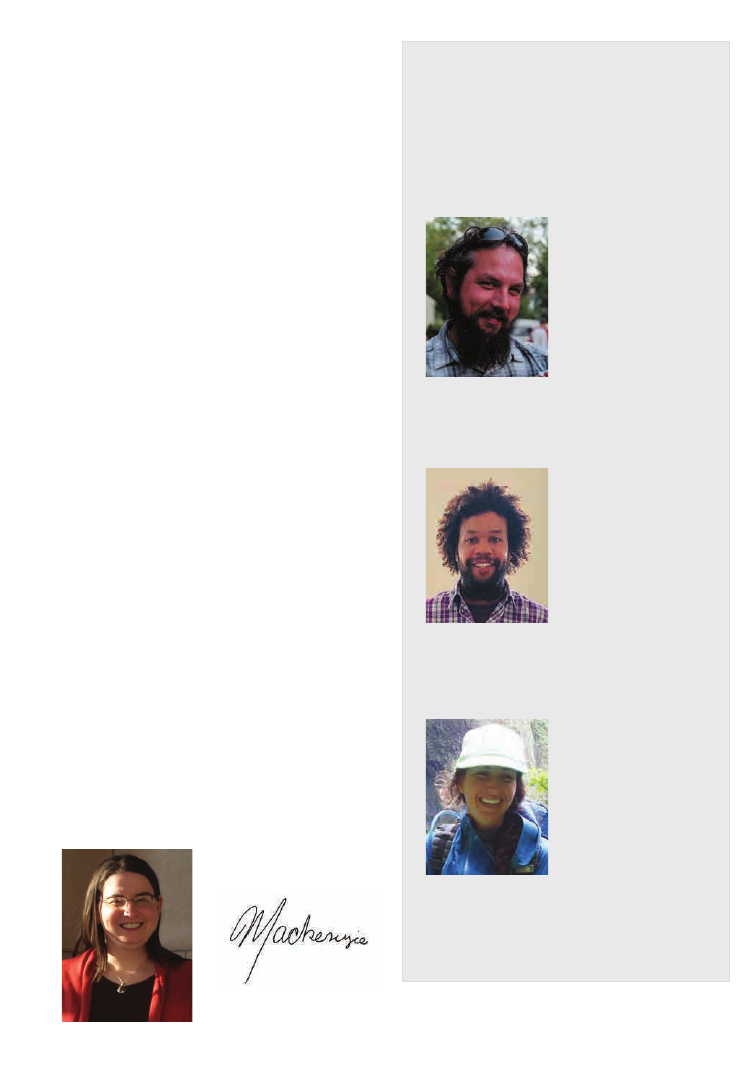
Summer 2021 Volume 67 Number 2
PLANT SCIENCE BULLETIN
Editorial Committee
Volume 67
From the Editor
David Tank
(2021)
Department of Biological
Sciences
University of Idaho
Moscow, ID 83844
dtank@uidaho.edu
James McDaniel
(2022)
Botany Department
University of Wisconsin
Madison
Madison, WI 53706
jlmcdaniel@wisc.edu
Seana K. Walsh
(2023)
National Tropical Botanical
Garden
Kalāheo, HI 96741
swalsh@ntbg.org
Greetings,
Summer 2021 is upon us and many of us are
still experiencing personal and professional
difficulties due to the global pandemic.
Operating conditions in many places in the
United States are slowly returning to normal
as vaccination rates have risen; however, there
is still great uncertainty as U.S. vaccinations
level off and Covid cases continue to
fluctuate globally. The second virtual Botany
conference will allow us to once again gather
in this new environment, albeit not in person.
In preparation for this meeting, we are excited
to feature many of our annual award winners
and introduce the new student representative
to the Executive Board, Ioana Anghel.
In this issue, we also present two articles that
consider the connections of people to plants.
In Dr. Kate Parsley’s article, she discusses
new strategies for describing and combatting
plant awareness disparity. I am particularly
pleased to feature this article as it furthers the
discussion on this issue that has been carried
on in the pages of Plant Science Bulletin
for several decades. Cole Imperi’s article
introduces the concept of Thanabotany and
the relationships people have with plants
in situations involving death. Recognizing
these types of relationships can only increase
people’s awareness of the importance of
plants in human culture and, hopefully, in
the environment. I hope you find these article
informative and inspiring. Sincerely,
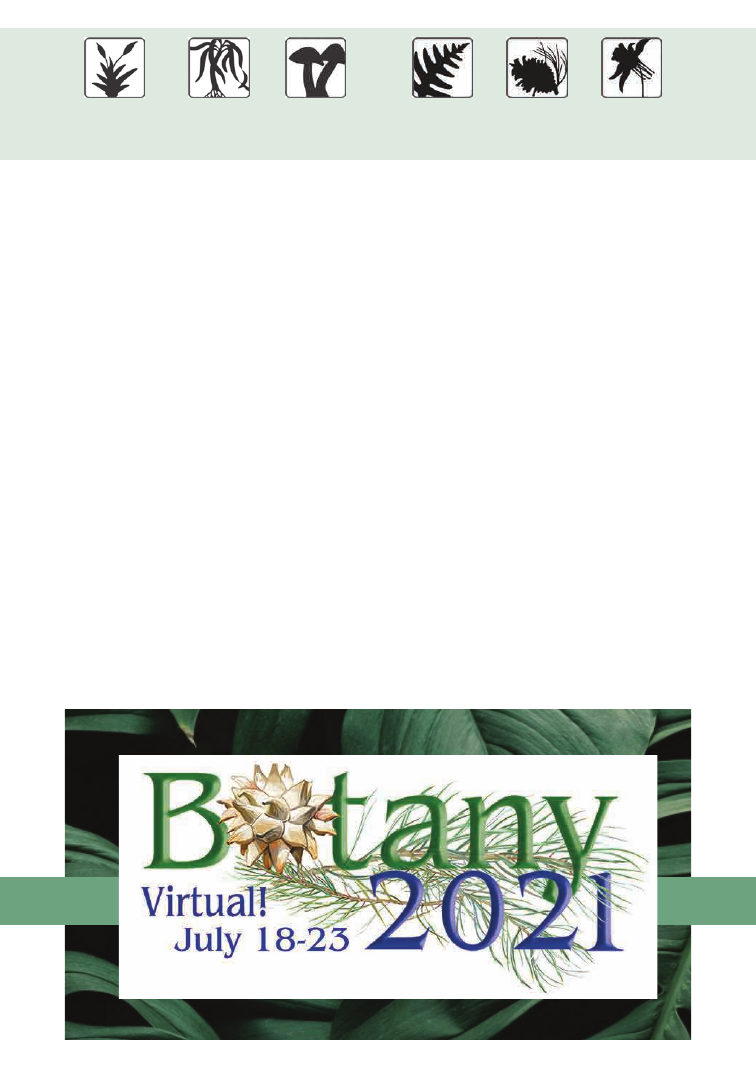
78
TABLE OF CONTENTS
SOCIETY NEWS
Meet the New BSA Board Members! ..................................................................................................................79
Botanical Society of America’s Award Winners (Part 1) .........................................................................80
SPECIAL FEATURES
Plant Awareness Disparity: Looking to the Past to Inform the Future .............................................94
Thanabotany: the Emerging Field Where Plants, People and Death Intersect .......................101
Poetry Corner ................................................................................................................................................................108
SCIENCE EDUCATION
PlantingScience Has Large Session, Successful Student/Scientist
Mentoring Conversations Despite Pandemic Disruptions ...................................................................112
STUDENT SECTION
Graduate School Advice .........................................................................................................................................116
Getting to Know your New Student Representative - Ioana Anghel .............................................120
MEMBERSHIP NEWS ...................................................................................................................................
122
ANNOUNCEMENTS
In Memoriam - Walter Lewis (1930–2020) .................................................................................................124
BOOK REVIEWS
............................................................................................................................................................................128
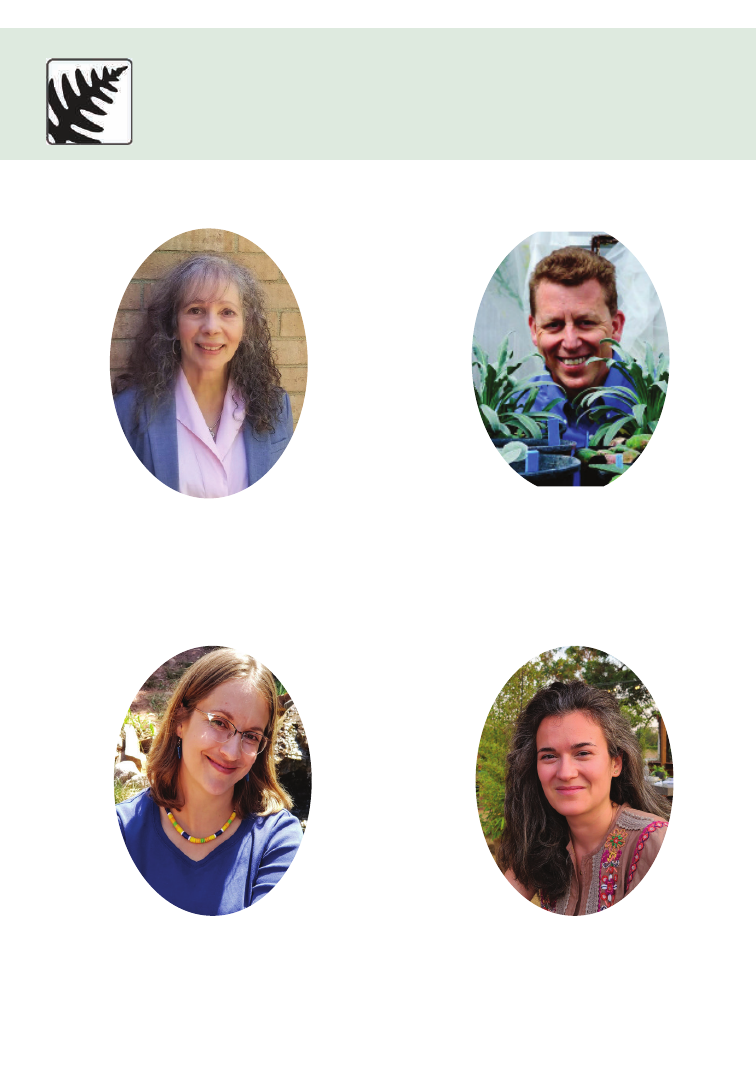
79
SOCIETY NEWS
Meet the New BSA Board Members!
Vivian Negron-Ortiz
President-Elect
U.S. Fish and Wildlife Service (USFWS),
Florida Ecological Services Field Office
J. Chris Pires
Secretary
University of Missouri - Columbia
Rachel Jabaily
Director-at-Large for Education
Colorado College
Ioana Anghel
Student Representative
University of California, Los Angeles
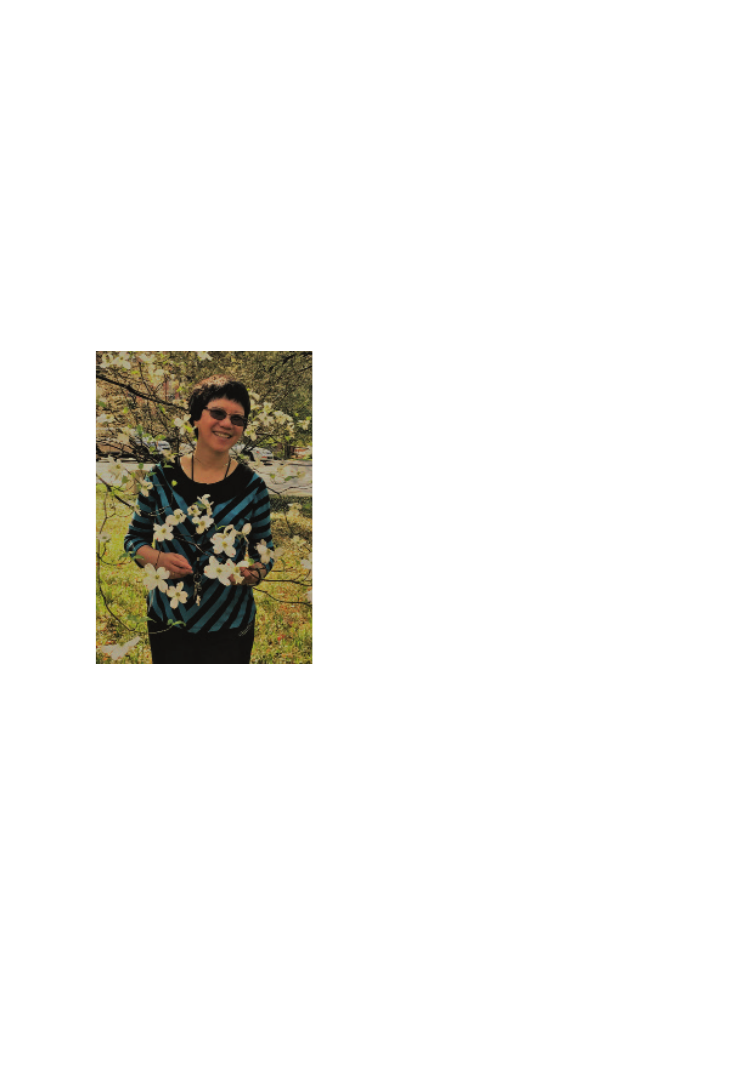
PSB 67(2) 2021
80
Dr. Xiang is well known globally for her
diverse contributions to plant systematics and
evolution. She is best known for her extensive
work on Cornaceae, for which she is the world’s
expert, as well as her numerous important
contributions to our understanding of the well-
known Eastern Asia–Eastern North America
floristic disjunction. Few groups of plants are
now as well-studied as dogwoods, thanks to
Jenny’s dedication. Her expertise is diverse
and spans classical taxonomy, molecular
BOTANICAL SOCIETY OF AMERICA’S
AWARD WINNERS (PART1)
Distinguished Fellow of the Botanical Society of America
The Distinguished Fellow of the Botanical Society of America is the highest honor our Soci-
ety bestows. Each year, the award committee solicits nominations, evaluates candidates, and
selects those to receive an award. Awardees are chosen based on their outstanding contribu-
tions to the mission of our scientific Society. The committee identifies recipients who have
demonstrated excellence in basic research, education, public policy, or who have provided
exceptional service to the professional botanical community, or who may have made contri-
butions to a combination of these categories.
DR. QIUYUN (JENNY) XIANG
North Carolina State University
systematics/phylogenetics, genomics,
and developmental genetics. Much of
her recent work focuses on population-level
and phylogeographic problems. She has an
extremely rich publication record and has
also maintained continuous NSF support
throughout her long career.
One of Dr. Xiang’s most important
contributions has been fostering close
interactions and research connectivity between
botanists in China and the United States. Since
2008, she and colleagues in China have taught
the “East Asia–North America Field Botany
and Ecology Course” at Zhejiang University
and North Carolina State University, making
a great impact on the training of Chinese
and American students in this field. This has
been a remarkable opportunity for students
from both countries and has helped to foster
new international research, as well as many
friendships. These student exchanges have
had significant impact on the number and
quality of collaborations between U.S. and
Chinese labs in the botanical sciences.
Jenny has been a life-long member of the
Botanical Society of America. She is an
outstanding mentor to students, post-docs,
and young faculty, often bringing them along
to annual scientific conferences including
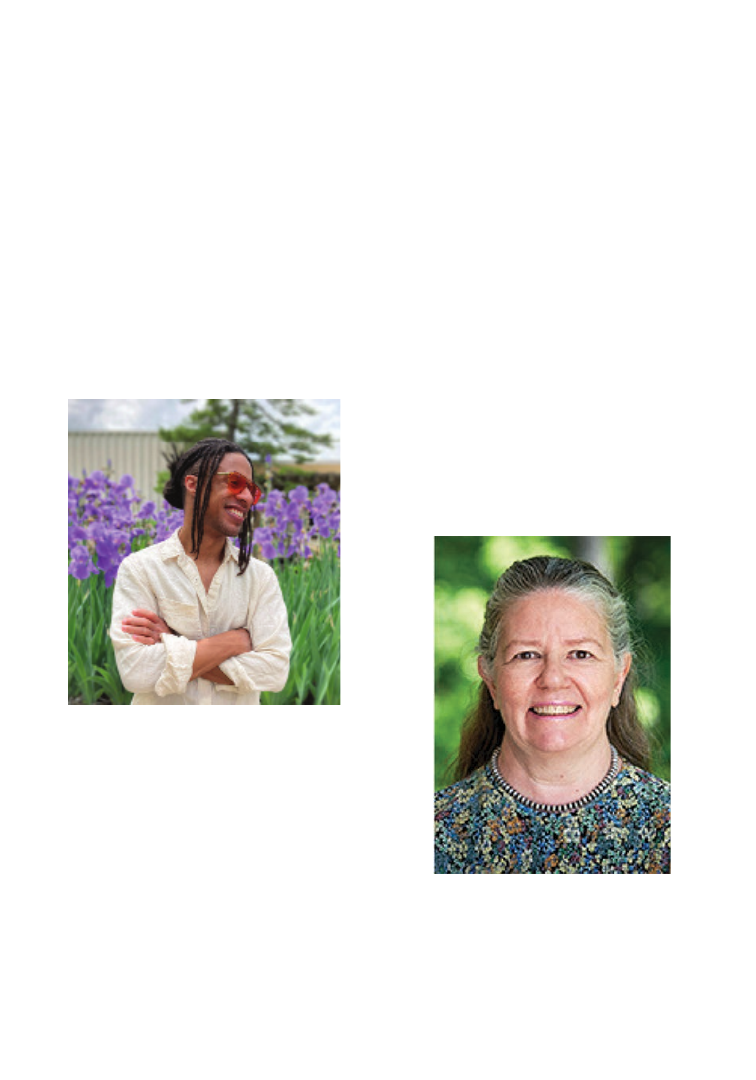
PSB 67(2) 2021
81
Botany conferences. Her courses have
inspired both plant biology majors and non-
majors to think more deeply about plant
evolution and diversity. She is well respected
and well loved by her mentees, whether they are
from the United States or China or elsewhere
in the world. In addition, Jenny has been an
active reviewer for the American Journal of
Botany, served on several BSA committees, is
a frequent organizer of workshops, symposia,
special journal issues, and more—all in service
to her profession.
BSA Emerging Leader Award
Donald R. Kaplan
Memorial Lecture
This award was created to promote research
in plant comparative morphology, the Kaplan
family has established an endowed fund,
administered through the Botanical Society
of America, to support the Ph.D. research of
graduate students in this area.
M. ALEJANDRA GANDOLFO-NIXON
Cornell University
DR. BRIAN ATKINSON
University of Kansas
Dr. Atkinson is currently Assistant Professor in
the Department of Ecology and Evolutionary
Biology at the University of Kansas and
curator of the paleobotany collection at the
KU Biodiversity Institute. Brian completed
his doctoral dissertation at Oregon State
University in 2017, after earning among other
awards, a NSF Doctoral Fellowship and the
BSA Paleobotanical Section Isabel Cookson
Award. Dr. Atkinson is one of the leading
scientists of his generation in paleobotany
and plant evolution. He is making impressive
contributions as a field-based scientist who
combines morphological and molecular
data, extant and extinct plants, as well as
biological and geological data. In addition,
Dr. Atkinson has become an accomplished
teacher, inspiring mentor, and an exceptional
role model.

PSB 67(2) 2021
82
BOTANY ADVOCACY LEADERSHIP GRANT
This award organized by the Environmental and Public Policy Committees of BSA and ASPT aims to
support local efforts that contribute to shaping public policy on issues relevant to plant sciences.
Rocio Deanna, University of Colorado-Boulder, for the Proposal: ARG Plant Women
Network
Karolina Heyduk, University of Hawaii, for the Proposal: Hawaiian Culture and the
Herbarium
Carolyn Mills, California Botanic Garden/Claremont Graduate University, for the Proposal
Promoting Indigenous Co-management of Federal Lands in the Nopah Range
DONALD R. KAPLAN AWARD
IN COMPARATIVE MORPHOLOGY
Donald R. Kaplan was a leading researcher in the area of plant form, where he sought to deduce fundamental
principles from comparative developmental morphology. Through his own work and the work of the many
graduate students he mentored, he had a profound effect on the fields of plant development and structure.
Kaplan always encouraged his students to work independently, often on projects unrelated to his own research.
He believed that students should publish their work independently, and rarely coauthored his students’ papers.
To promote research in plant comparative morphology, the Kaplan family has established an endowed fund,
administered through the Botanical Society of America, to support the Ph.D. research of graduate students in this
area. The annual award of up to $10,000 may be used to support equipment and supplies, travel for research and
to attend meetings, and for summer support. This award was created to promote research in plant comparative
morphology, the Kaplan family has established an endowed fund, administered through the Botanical Society of
America, to support the Ph.D. research of graduate students in this area.
Erin Patterson, University of Massachusetts, Amherst, for the Proposal: The development and
evolution of awns in the grass subfamily Pooideae
Honorable Mention:
Jacob Suissa, Harvard University, for the Proposal: Bumps in the node: the effects of vascular
architecture on hydraulic integration in fern rhizomes

PSB 67(2) 2021
83
THE BSA GRADUATE STUDENT RESEARCH AWARD
INCLUDING THE J. S. KARLING AWARD
The BSA Graduate Student Research Awards support graduate student research and are made on the basis of research
proposals and letters of recommendations. Withing the award group is the Karling Graduate Student Research Award.
This award was instituted by the Society in 1997 with funds derived through a generous gift from the estate of the
eminent mycologist, John Sidney Karling (1897-1994), and supports and promotes graduate student research in the
botanical sciences. The 2021 award recipients are:
THE J. S. KARLING GRADUATE
STUDENT RESEARCH AWARD
Isabela Lima Borges, Michigan State University, for the Proposal: The effects of plant inbreeding
on the legume-rhizobia mutualism
THE BSA GRADUATE STUDENT RESEARCH AWARDS
Laymon Ball, Louisiana State University, for the Proposal: Mutualisms, mountains, and machine
learning: Disentangling drivers of evolution in a florally diverse Neotropical plant clade, Hillieae
(Rubiaceae)
Philip Bentz, University of Georgia, for the Proposal: Origins and evolution of genetic sex-
determination and sex chromosomes in the genus Asparagus
Haley Branch, University of British Columbia, for the Proposal: Remembering the hard times:
how stress memory evolves in response to environmental pressure
Stephanie Calloway, California Polytechnic State University, San Luis Obispo, for the Proposal:
Saving a rare plant species from extinction on Anacapa Island
Anri Chomentowska, Yale University, for the Proposal: Investigating the evolution of syndromes:
life history, mating system, and environmental niche of a desert-alpine lineage in the plant family
Montiaceae
Eva Colberg, University of Missouri - St. Louis, for the Proposal: The effects of prescribed fire on
ant-mediated seed dispersal of Sanguinaria canadensis
Mari Cookson, Cal State Fullerton, for the Proposal: Investigating systematics and host-parasite
coevolutionary dynamics in dwarf mistletoes (Arceuthobium spp.) using population genomics
Brandon Corder, University of Wisconsin-Madison, for the Proposal: Partial mycoheterotrophy
in North American orchids: incorporating evolutionary ecological and molecular evolutionary
approaches

PSB 67(2) 2021
84
Sontosh Deb, University of Alabama, For the Proposal: Evolution of flooding tolerance in maize
relatives
Caroline Dowling, University College Dublin, For the Proposal: The genetic architecture of
flowering time in Cannabis sativa
Samar El-Abdallah, Humboldt State University, For the Proposal: Constructing whole plant
concepts for two Early Devonian fossil plants in the assemblages of the Beartooth Butte Formation
(Wyoming)
Paige Fabre, The Ohio State University, For the Proposal: Patterns of staminode evolution in
Penstemon (Plantaginaceae)
Laura Fehling, Miami University, For the Proposal: Context-dependency of reward
complementarity in a multispecies mutualism
Emma Frawley, Washington University in St. Louis, For the Proposal: Little barley: variation,
domestication, and adaptation in a North American lost crop
Elsa Godtfredsen, Northwestern University, for the Proposal: Early snowmelt, changing
phenology and increased drought exposure: consequences for plant survival and reproduction of
four subalpine plant species
Nikolai Hay, Duke University, for the Proposal: Locating a “missing link” using microsatellite
data from herbarium specimens
Zhe He, Harvard University, for the Proposal: Pit membranes and plant resistance to cavitation
Samuel Lockhart, Ohio University, for the Proposal: Population genetic structure and breeding
system characterization of four mixed-breeding violets and one exclusively chasmogamous violet
Diana Macias, University of New Mexico, for the Proposal: Adaptability of piñon pine (Pinus
edulis) populations to future hot droughts
Janet Mansaray, Louisiana State University, for the Proposal: Plants, ants, and curvy bills: the
evolution of mutualisms in neotropical bellflowers
Skylar McDaniel, Utah State University,for the Proposal: Floral microbiome assembly and
function in the face of phenological change
Michael McKibben, University of Arizona, for the Proposal: The Contribution of paleopolyploidy
to adaptation in diploid descendants

PSB 67(2) 2021
85
Elise Miller, University of Minnesota Duluth, for the Proposal: How do sources, sinks, and
physical constraints impact phloem hydraulic conductivity?
Carina Motta, Universidade Estadual Paulista – Rio Claro, for the Proposal: Contribution of a
naturalized tropical tree to bird diet in secondary forest fragments
Taryn Mueller, University of Minnesota, for the Proposal: Ecological genetic drivers of foliar
fungal endophyte community assembly in Clarkia xantiana
Olivia Murrell, Northwestern University, for the Proposal: Influence of metapopulation dynamics
on genetic structure: Case study of the endangered and exceptional species Amorphophallus
titanium
Deannah Neupert, Miami University, for the Proposal: The evolution and development of the
aerial bulbil: a study of novelty in Mimulus
Megan Nibbelink, Humboldt State University,
for the Proposal: Anatomically-preserved
zosterophylls of the Battery Point Formation (Québec, Canada) and a new analysis of zosterophyll
relationships
Kasey Pham, University of Florida, for the Proposal: What got swapped? Investigating the
genomic consequences of hybridization in two species of Eucalyptus
Alyssa Phillips, UC Davis, for the Proposal: Origins of polyploidy and their impact on adaptation
in Andropogon gerardi
Neill Prohaska, University of Arizona, for the Proposal: How does leaf microclimate affect
population density and diversity of microbes living on leaves in tropical forest canopies?
Austin Rosen, Colorado State University, for the Proposal: Uncovering taxonomic boundaries
in a group of seep-loving desert thistles (Asteraceae: Cirsium)
Malia Santos, University of Idaho, for the Proposal: Investigating species relationships and
evolutionary patterns of defense strategies in Tricalysia (Rubiaceae)
Amber Stanley, University of Pittsburgh, for the Proposal: Have floral traits of Impatiens
capensis responded to pollinator mismatches caused by climate change and urbanization? A
retrospective study using herbarium specimens
Christina Steinecke, Queen’s University, for the Proposal: Investigating correlated evolution of
sexual and asexual reproduction in Mimulus guttatus
Andrea Turcu, The University of Louisiana at Lafayette, for the Proposal: The evolution of
divergent mating systems across temporally and spatially heterogeneous environments

PSB 67(2) 2021
86
Emma Vtipilthorpe, North Carolina State University, for the Proposal: Relationships between
niche breadth and geographic range size in Liatris
Sophie Young, Lancaster University, for the Proposal: Phloem loading in the context of C4
photosynthesis in tree-form Hawaiian Euphorbia
Joseph Zailaa, Yale University, for the Proposal: Investigating drought impacts on native-
California shrubland vegetation from cells to communities
THE BSA UNDERGRADUATE
STUDENT RESEARCH AWARD
The BSA Undergraduate Student Research Awards support undergraduate student research and are
made on the basis of research proposals and letters of recommendation.
Anais Barnes, Bucknell University, for the Proposal: Assessing the geographic distribution and
conservation status of Heuchera alba and Heuchera pubescens using field surveys, morphology and
genomics methods
Jeffrey Heim, Bucknell University, for the Proposal: A population genomics approach to under-
standing the role of Indigenous foragers in the distribution and genetic diversity of an Australian wild
bush tomato (Solanum diversiflorum)
Matthew Hilz, Saint Louis University, for the Proposal: Testing the effect of plant age on phenotypic
traits in the field
Hsin Kuo, National Taiwan University, for the Proposal: Evolution of the AUXIN RESPONSE FAC-
TOR gene family in land plants
Claire Marino, Bucknell University, for the Proposal: Solanum sp. ‘Deaf Adder,’ a new bush tomato
species from the Australian monsoon tropics
Theodore Matel, Cornell University, for the Proposal: Cunoniaceae fossil from the early Eocene
(~58 m. y.) Laguna del Hunco, Huitrera Formation, Patagonia, Argentina
Ryan McGinnis, Drake University, for the Proposal: Battle of the sexes: Intra- and Interindividual
floral variation in a native fruit tree, American persimmon (Diospyros virginiana, Ebenaceae)
Nola Rettenmaier, Cornell University, for the Proposal: Assessing NAM/CUC3 Expression in Costus
spicatus
Nicholas Rocha, Cornell University, for the Proposal: The role of pollinators in the phenotypic diver-
sity of Calochortus venustus
Aryaman Saksena, Cornell University, for the Proposal: Evolution of floral fusion in the banana
families
Emily Smith, Drake University, for the Proposal: The function of staminodes in the reproductive suc-
cess and pollination ecology of American Persimmon, Diospyros virginiana (Ebenaceae)
Ethan Stolen, University of Florida, for the Proposal: The impact of genome doubling on gene ex-
pression noise in Arabidopsis thaliana

PSB 67(2) 2021
87
THE BSA YOUNG BOTANIST AWARDS
The purpose of these awards is to offer individual recognition to outstanding graduating seniors in
the plant sciences and to encourage their participation in the Botanical Society of America.
Andrea Appleton, Georgia Southern University, Advisor: Dr. John Schenk
Olyvia Foster, University of Guelph, Advisor: Dr. Christina Caruso
Renée Geyer, Oberlin College, Advisor: Dr. Michael J. Moore
Jonathan Hayes, Bucknell University, Advisor: Dr. Christopher T. Martine
Jeff Heim, Bucknell University, Advisor: Dr. Christopher T. Martine
Emily Humphreys, Oberlin College, Advisor: Dr. Michael J. Moore
Kiana Lee, University of Guelph, Advisor: Dr. Christina Caruso
Michelle Liu, Oberlin College, Advisor: Dr. Michael J. Moore
Tallia Maglione, Connecticut College, Advisor: Dr. Rachel Spicer
Jordan Manchego, University of Alabama-Huntsville, Advisor: Dr. Alex Harkess
Livia Martinez, Barnard College - Columbia University, Advisor: Dr. Hilary Callahan
Colleen Mills, Weber State University, Advisor: Dr. Sue Harley
Abigail Moore, Ohio University, Advisor: Dr. John Schenk
Claire Pellegrini, Connecticut College, Advisor: Dr. Rachel Spicer
Eva Popp, Rutgers, The State University of New Jersey, Advisor: Dr. Steven Handel
Riki Ross, University of Akron, Advisor: Dr. Randall Mitchell
Megan Soehnlen, Walsh University, Advisor: Dr. Jennifer Clevinger
Heather Wetreich, Bucknell University, Advisor: Dr. Christopher T. Martine
Shefka Williams, Connecticut College, Advisor: Dr. Rachel Spicer

PSB 67(2) 2021
88
THE BSA PLANTS GRANT RECIPIENTS
The PLANTS (Preparing Leaders and Nurturing Tomorrow’s Scientists: Increasing the diversity of
plant scientists) program recognizes outstanding undergraduates from diverse backgrounds and pro-
vides travel grant.
Anais Barnes, Bucknell University, Advisor: Chris Martine
Serena Blais, California State University, Sacramento, Advisor: Clayton Visger
Jonathan Carcache, Florida International University, Advisor: Daniela Hernandez
Josh Felton, Colorado College, Advisor: Rachel Jabaily
Aaliyah Holliday, Cornell University, Advisor: Chelsea D. Specht
Caitlyn Hughes, University of Georgia, Advisor: Jim Leebens-Mack
Emily Hughes, Rutgers University, Advisor: Suzanne Sukhdeo
Al Lichamer, University of Wisconsin-Madison, Advisor: Ingrid Jordon-Thaden
Annie Nelson, University of Nebraska- Lincoln, Advisor: Katarzyna Glowacka
Matthew Norman, Atlanta Botanical Garden, Advisor: Lauren Eserman
Deirdre O’Malley, Hobart and William Smith Colleges, Advisor: Shannon Straub
Ryan Schmidt, Rutgers University, Advisor: Lena Struwe
Madilyn Vetter, University of Wisconsin Eau Claire, Advisor: Nora Mitchel
Jayla Wade, Howard University, Advisor: Dr. Janelle Burke
Audrey Widmier, Mercer University, Advisor: Dr. John Stanga
THE BSA DEVELOPING NATIONS TRAVEL GRANTS
Yetunde Bulu, Adekunle Ajasin University, Akungba-Akoko, Nigeria
Paula Burchardt, Londrina State University (UEL), Brazil
Laura Calvillo Canadell, Instituto de Biología, UNAM., Mexico

PSB 67(2) 2021
89
Ítalo Coutinho, Universidade Federal do Ceará, Brazil
Kelsey Glennon, University of the Witwatersrand, South Africa
Thliza Ijai Ayuba, Federal University, Gashua, Yobe State, Nigeria
Yesenia Madrigal, Universidad de Antioquia, Colombia
Oluwasanmi Odeyemi, Federal College of Animal Health and Production Technology, Nigeria
Oluwatobi OSO, University of Ibadan, Nigeria
Vashist N. Pandey, DDU Gorakhpur University, Gorakhpur, India
Nantenaina Herizo Rakotomalala, Kew Madagascar Conservation Centre, Madagascar
THE BSA STUDENT AND POSTDOC TRAVEL AWARDS
Winners were selected by lottery
Diana Castillo Diaz
Paige Ellestad
Chuangwei Fang
Matias Köhler
Jessica LaBella
Francesco Martini
SOUTHEASTERN SECTION STUDENT
PRESENTATION AWARDS
The following winners were selected from the Association of Southeastern Biologists meeting that took place at the end
of March, 2021.
Southeastern Section Paper Presentation Award
Emily Oppmann, Middle Tennessee State University
Funmilola Mabel Ojo
Namrata Pradhan
Laura Super
Yingtong Wu
Mei Yang
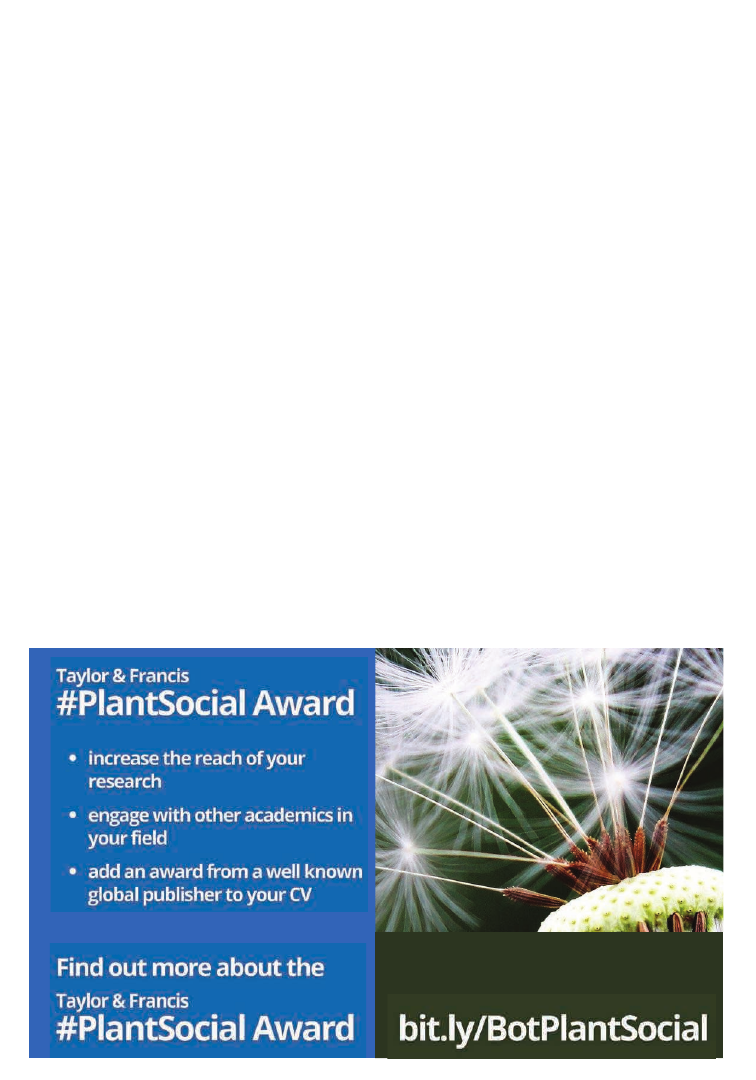
PSB 67(2) 2021
90
Southeastern Section Poster Presentation Award
Regina Javier, Appalachian State University
ECOLOGICAL SECTION STUDENT TRAVEL AWARDS
Mimi Serrano, San Francisco State University, Advisor: Dr. Kevin Simonin, for the
Presentation: Tracking Leaf Trait Differentiation of Newly Diverging Subspecies of Chenopodium
oahuense on the Hawaiian Islands
Laura Super, University of British Columbia, Advisor: Dr. Robert Guy, for the Presentation: The
impact of simulated climate change and nitrogen deposition on conifer phytobiomes and associated
vegetation Co-author: Dr. Robert Guy
Yingtong Wu, University of Missouri - St. Louis, Advisor: Dr. Robert E. Ricklefs, for the
Presentation: What Limits Species Ranges? Investigating the Effects of Biotic and Abiotic Factors
on Oaks (Quercus spp.) through Experiments and Field Survey Co-author: Dr. Robert E. Ricklefs
PTERIDOLOGICAL SECTION & AMERICAN FERN
SOCIETY STUDENT TRAVEL AWARDS
Ana Gabriela Martinez Becerril, National Autonomous University of Mexico, UNAM. Faculty
of Higher Studies Zaragoza, Advisor: Alejandra Vasco, for the Proposal: Disentangling the
systematics of the Elaphoglossum petiolatum complex (Dryopteridaceae) Co-author: Alejandra Vasco
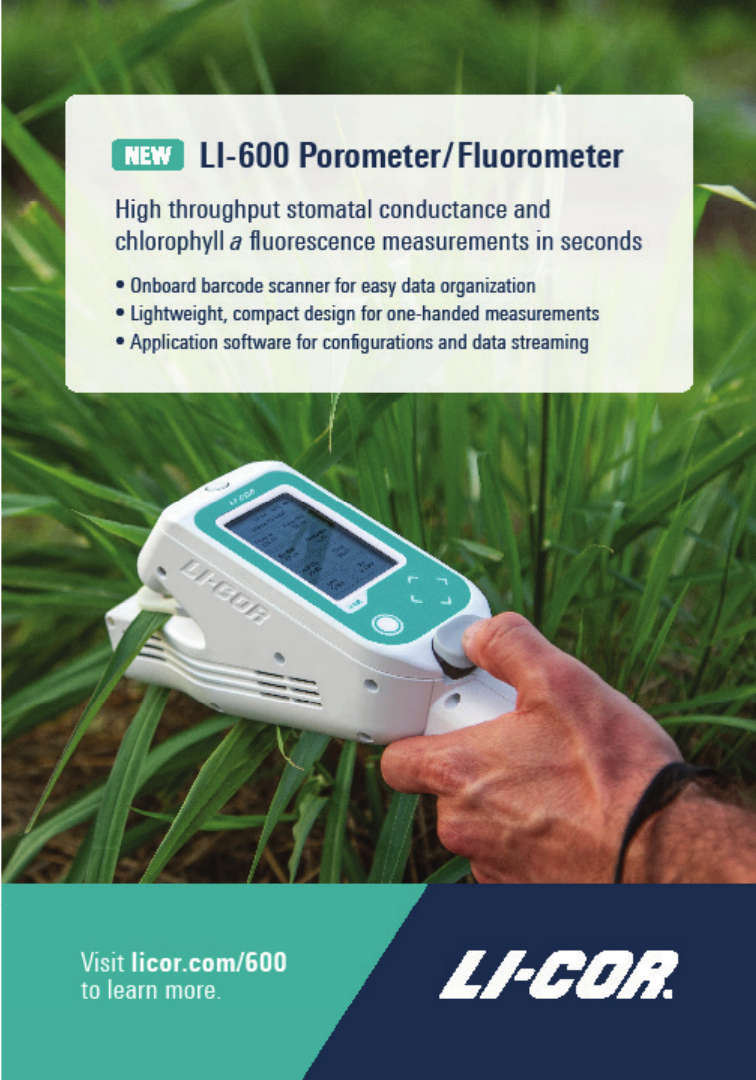
PSB 67(2) 2021
91

PSB 67(2) 2021
92
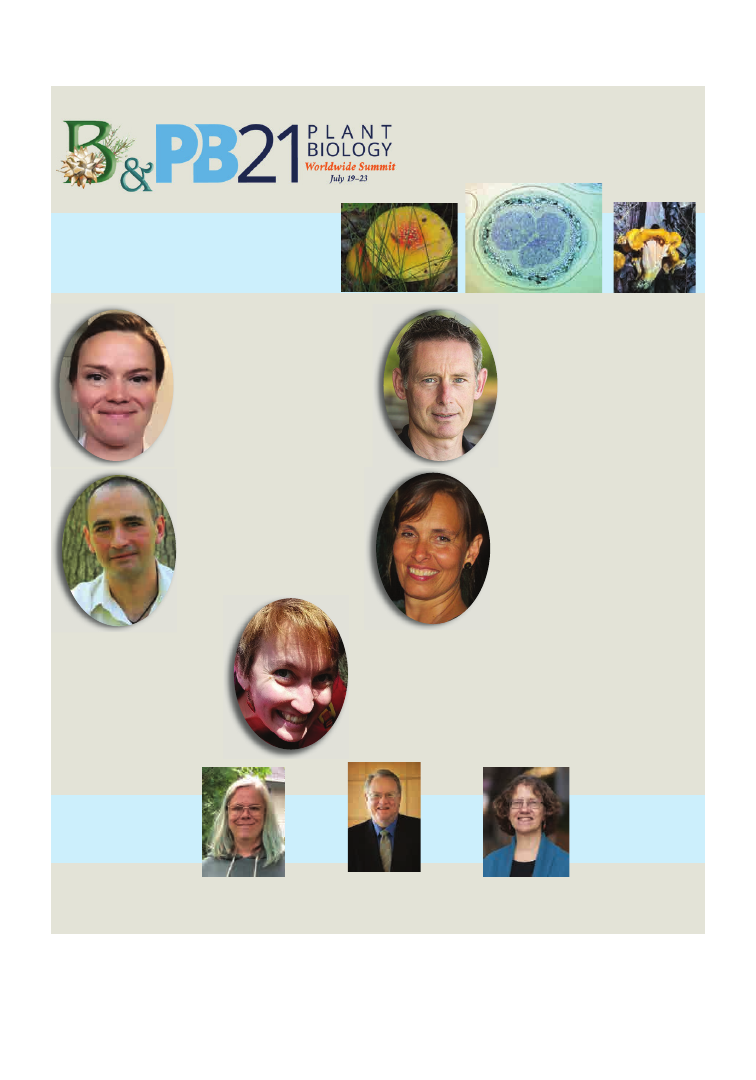
PSB 67(2) 2021
93
Botany 2021 and Plant Biology 2021
Present a Special Joint Symposium
Wednesday July 21, 11:00 am (ET)
Symbiotic forms and the
lichenized phenotype
Klara Scharnagl
University of California, Berkeley
Heather Hallen-Adams
University of Nebraska-Lincoln
Mycological Society of America
Elizabeth Kellogg
The Danforth Center
Botanical Society of America
Gary Stacey
University of Missouri
American Society of
Plant Biologists
Bacterial endosymbionts of
Mucoromycota fungi;
lessons from evolutionary,
functional, and
computational genomics
Jessie Uehling
Oregon State University
Perception of
lipo-chitooligosaccharides
by the bioenergy crop
Populus
Jean-Michel Ané
University of Wisconsin
Bidirectional communication
along the
microbiome-root-shoot axis.
Corné Pieterse
Utrecht University
A set of conserved receptors
is essential for root system ar-
chitectural changes induced by
arbuscular mycorrhizal fungi
Uta Paszkowski
Cambridge University
Organized by:
An Exploration of
Inter-kingdom Interactions
Featuring:

94
SPECIAL FEATURES
A SHORT HISTORY OF
PLANT BLINDNESS
Many readers of the the Plant Science Bulletin
are likely familiar with a problem that has
plagued botanists and science educators for at
least a century: most students are not interested
in learning about plants. This simple fact has
been written about extensively, both within
this very publication and throughout the field
of botany education research (e.g., Balas and
Momsen, 2014; Hershey, 2002; Strgar, 2007;
Wandersee, 1986; Wandersee et al., 2006;
Wandersee and Schussler, 1999; Wandersee
and Schussler, 2001).
Plant Awareness Disparity: Looking
to the Past to Inform the Future
By Kathryn M. Parsley
Education Project
Manager
Education Research and
Outreach Laboratory
Donald Danforth Plant
Science Center
What many people do not often recognize
is that the history of this problem is more
extensive than it seems on the surface. The
original idea behind plant blindness first
surfaced in the journal Science in 1919, when
George Nichols discussed the teaching of
botany and zoology in American universities
and how the development of general biology
courses would affect these topics. In the
article, Nichols laments that these new general
biology courses “are responsible for the
popular delusion that biology is the study of
animals: that the words biology and zoology
are synonymous,” (Nichols, 1919). Before
this phenomenon even had a name, plant
blindness was recognized as a major problem
for biology education.
Several years later, in 1994, the term
“zoochauvinism” appeared on the scene.
Zoochauvinism is known as a bias against
plants in favor of animals, and while this
term appeared first in the literature, it is now
largely recognized as a consequence of plant
blindness (Bozniak, 1994; Hershey, 1993;
Wandersee and Schussler, 2001). Shortly
after, the term “plant blindness” was coined
by James Wandersee and Elisabeth Schussler
(Wandersee and Schussler, 1999, 2001).
Email: kparsley@danforthcenter.org
Twitter and Instagram @KathrynMParsley
Website: www.kathrynmparsley.com
Blog: https://plantawarenessdisparity.word-
press.com/

PSB 67(2) 2021
95
Plant blindness is defined as “the inability
to see or notice the plants in one’s own
environment—leading to: (a) the inability
to recognize the importance of plants in
the biosphere, and in human affairs; (b)
the inability to appreciate the aesthetic and
unique biological features of the life forms
belonging to the Plant Kingdom; and (c)
the misguided, anthropocentric ranking of
plants as inferior to animals, leading to the
erroneous conclusion that they are unworthy
of human consideration,” (Wandersee and
Schussler, 2001). This definition can be
extrapolated into four components of plant
blindness: attention, attitude, knowledge, and
relative interest (Parsley, 2020). The attention
component refers to the visual phenomenon of
not noticing plants in an environment, which
is supported by research in visual cognition
(Balas and Momsen, 2014; Norretranders,
1998; Parsley, 2020). The attitude component
is denoted by a lack of positive affect toward
plants and/or being apathetic toward them
(Parsley, 2020; Parsley et al., in review). The
knowledge component refers to the inability
to recognize the importance of plants in
the biosphere and human affairs (Parsley,
2020; Uno, 2009; Wandersee and Schussler,
2001). The relative interest component is
characterized by a lack of interest in plants
when compared to animals (Lindemann‐
Matthies, 2005; Parsley, 2020; Wandersee,
1986; Wandersee and Schussler, 2001).
These four components and the detailed
definition of plant blindness indicate that
this phenomenon goes much further than
simply not noticing plants. These attentional
deficits cascade into impacts on student
attitude, interest, and knowledge, and each
is an important component to student
learning. This makes plant blindness a multi-
faceted, complex problem that has significant
implications for biology and botany education.
As such, what we call the phenomenon and
the language we use to describe it matters. In
the past few years, botanists and educators
have spoken out about the problems with the
term plant blindness and how it is inherently
exclusive toward disabled scientists. For
example, McDonough MacKenzie
et al. (2019)
posited that instead of focusing on “curing
plant blindness,” we should instead seek to
“grow plant love.” While the ideas behind the
term are not in question (no one is proposing
to change the definition cited above), the term
itself has been identified as a potential barrier
to diversity and inclusion within the plant
sciences.
MOVING AWAY FROM
THE TERM
“PLANT BLINDNESS”—
WELCOMING DIVERSITY,
ACCESSIBILITY, AND
INCLUSION
Although the term plant blindness is unique
in that it captures an incredibly complex
phenomenon in a simple and easily digestible
phrase, it is still highly problematic in other
ways. The authors who developed this term
used a disability metaphor, and while ableism
was not the authors’ intention, disability
metaphors are inherently ableist (McDonough
MacKenzie et al., 2019; Sanders, 2019).
Disability metaphors equate disabilities with
negative or undesirable traits that require
“fixing” (Schalk, 2013; Smith, 2015). As
someone who is visually impaired and has
learning disabilities, I must admit that I do find
it problematic to equate blindness with not
noticing plants in my environment. If we are to

PSB 67 (2) 2021
96
promote a diverse and equitable environment
in which everyone feels comfortable learning
about plants, it is important that we choose
language to reflect these goals.
As such, I have proposed that we change
the term plant blindness to a new one: plant
awareness disparity (PAD) (Parsley, 2020).
Plant awareness disparity is accurate,
inclusive, and maintains the conceptual
intentions behind the original term. PAD
highlights the fact that the root of the problem
with this phenomenon is a disparity in visual
attention between plants and animals. The
problem is not just that we do not see plants,
it is that our visual systems have evolved to
place plants in the background of our visual
field in service of noticing animals (Parsley,
2020). At the same time, it recognizes that this
visual cognition reality creates the other three
components of PAD. This attention disparity
between plants and animals is responsible for
the development of negative attitudes toward
plants, a lack of interest in plants, and a lack
of knowledge of why plants are important
(Parsley, 2020). As such, PAD emphasizes
the visual roots of the phenomenon while
still encompassing the rest of the original
definition of plant blindness. Because PAD is
both more inclusive and continues to preserve
the integrity of the definition behind plant
blindness, I have begun using PAD to refer to
this phenomenon instead of plant blindness.
I encourage others to do the same for the
reasons outlined above.
PAD IN EDUCATIONAL
SYSTEMS AND TOOLS
PAD is present at all levels of education and
can even be transmitted from teachers to
students. For example, Nyberg et al. (2019)
noted that elementary school student teachers
notice plants in environments where plants
are in the foreground (such as botanical
gardens), much more than in environments
where animals are the focus (such as a science
center). These findings regarding student
teachers are significant, because if student
teachers do not have experiences with plants
in the foreground, their PAD levels may
continue uninhibited until they begin teaching
students. Once they do, these new teachers
may favor animals in biology examples,
leading to PAD in their students as well. There
is even evidence that high school students do
not perceive plants as being alive, partly due
to plants’ lack of observable motion (Yorek et
al., 2009). PAD does not automatically decline
over time without an intentional intervention.
Examples of intentional interventions include:
educational curriculum, the introduction of a
plant mentor (someone who mentors others
and teaches them about the importance of
plants), or the special interest and enthusiasm
of a teacher.
PAD is even a problem within the very
instructional tools that we use to teach
biology. Schussler et al. (2010) discovered that
even in two nationally syndicated textbook
series in the United States, animals and
plants are represented unequally. There were
more than twice as many animal examples
as plant examples in the textbooks. Even in
highly regarded and frequently used general
biology textbooks at the university level, this
trend continues. Brownlee et al. (2021) noted
a similar tendency for textbooks to represent
animals in images more often than plants
(and focus on animals in images containing
both plants and animals). PAD is infused into
instructional materials at all educational levels
in the United States. As one might imagine,
this has disastrous consequences for botanical

PSB 67(2) 2021
97
literacy and botany education. If students
are not exposed to both plant and animal
examples of biological concepts, they can
come away with misconceptions such as that
plants do not evolve.
HOW TO COMBAT PAD
IN AND OUTSIDE OF THE
CLASSROOM
Given how ubiquitous PAD is at all levels of
education (particularly in the United States),
many authors have explored strategies to
reduce PAD in a multitude of contexts.
Wandersee et al. (2006) probed community
college students’ botanical sense of place to
help them see and understand how plants are
important to not only the students, but also
humans in general. Frisch et al. (2010) used
this approach to help educate science teachers
about why teaching plants in elementary
school is important as well.
A proposed way to alleviate PAD in K-12
students is through an outdoor education
program, where students (ages 10 and 11)
have hands-on opportunities to interact with
the plants (Fančovičová and Prokop, 2011).
Wyner and Doherty (2019) demonstrated
that local street trees can be used to decrease
urban middle school students’ levels of PAD,
despite a lack of large outdoor spaces present
in these urban environments. Patrick and
Tunnicliffe (2011) demonstrated that children
of the ages 4, 6, 8, and 10 are in touch with
their environment to varying extents, and that
children who have rich experiences outdoors
tend to have more knowledge about both
plants and animals.
Outside of formal learning environments,
Hoekstra (2000) noted that in order to help
combat PAD, botanists should partner with the
media and get better at presenting information
in a relatable and entertaining way. Hershey
(2002) had several ideas for combating PAD:
a college course for preservice teachers, an
online botanical glossary, a botanical seal of
approval on biology textbooks from botanists,
and even a bibliography of accurate botanical
and biological teaching materials. Wandersee
and Schussler (2001) noted that having a
knowledgeable and friendly plant mentor has
also been shown to result in lowered PAD
in students. Having experiences with a plant
mentor also results in increased attention to,
interest in, and scientific understanding of
plants at a later point in life for many people.
Wandersee and Schussler took an activist
approach in their 1999 paper, in which
they announced that they were launching a
campaign to “prevent plant blindness,” as it
was then called, which was followed up with
special posters to hang in classrooms and
even a children’s book about a plant. To follow
up with this idea, they even created an award
called the Giverny Award for children’s books
that accurately teach at least one scientific
principle, and preference is given to books
that teach about botany and plant biology.
NEW STRATEGIES AND
SUGGESTIONS FOR
APPROACHING PAD
In the Classroom
Parsley et al. (in review) note that when
designing ways to reduce PAD in students, it
is important to consider that simply teaching
students may not be enough. We found
that even after an active learning botanical

PSB 67 (2) 2021
98
curriculum, only student attention and
knowledge of plants improved significantly—
their attitudes and interest in plants did not
(Parsley et al., in review). This is important
because if we are to reduce PAD, we have to
be sure to address the problem from a more
holistic perspective. Botanists and instructors
cannot rely on increased knowledge alone to
change students’ minds about plants.
Introductory biology textbooks need to
improve their representation of plants in
images at both the elementary and university
levels (Schussler et al., 2010; Brownlee et al.,
2021). Instructors who are using textbooks
with high levels of PAD should incorporate
outside resources such as herbarium
specimens, online repositories such as
botanydepot.com, and even botanical social
media accounts to better represent plants in
their classes (Brownlee et al., 2021).
In Personal Experiences
Making plants personal seems to be a major
strategy to help combat PAD. Krosnick et
al. (2018) noted that personal experience
growing plants and treating them as pets can
also have an effect on PAD. When students get
personally invested in these activities, it can
help them develop those feelings of empathy
that also develop when they have a plant
mentor or have significant memories of being
around plants in their childhood.
Notably, my research (both in exploring
the literature and in conducting my own
research studies) indicates that interpersonal
relationships are an important part of reducing
PAD. Often the relationship with a plant
mentor, family member, or friend is what gets
students interested in plants. It typically takes
students being taught by another person how
to empathize with plants, while this seems to
happen automatically with animals.
As instructors, botanists, and outreach
activists, we can take on this role for our
students. We can go the extra mile to
demonstrate our enthusiasm for plants, and to
encourage the same in our students. And, if
we are ever going to be rid of PAD, we must do
these things. To advance in the fight against
PAD and botanical illiteracy, I am proposing a
social media campaign specific to PAD.
Online
On Twitter or Instagram, use #PADisBad
to tell the world how you are fighting PAD
with educational curricula, field trips,
active learning activities, or even science
communication methods. If you have funny
memes related to PAD, ideas for interventions
to reduce PAD, or if you just want to show
others how PAD affects their lives, #PADisBad
can help get the word out. The more people
involved in this discussion, the more likely we
are to make a difference in PAD and botanical
literacy, not only for our students, but also for
the public at large.
LITERATURE CITED
Balas, B., and J. L. Momsen. 2014. Attention “blinks”
differently for plants and animals. CBE-Life Sciences
Education 13: 437-443.
Bozniak, E. C. 1994. Challenges facing plant biology
teaching programs. Plant Science Bulletin 40: 42–46.
Brownlee, K., K. M. Parsley, and J. L. Sabel. 2021. An
analysis of plant awareness disparity within introduc-
tory biology textbook images. Journal of Biological
Education. https://doi.org/10.1080/00219266.2021.19
20301
Fančovičová, J., and P. Prokop. 2011. Plants have a
chance: outdoor educational programmes alter stu-
dents’ knowledge and attitudes towards plants. Envi-
ronmental Education Research 17: 537-551.

PSB 67(2) 2021
99
Frisch, J. K., M. M. Unwin, and G. W. Saunders. 2010.
Name that plant! Overcoming plant blindness and de-
veloping a sense of place using science and environ-
mental education. In The inclusion of environmental
education in science teacher education (pp. 143-157).
Springer, Dordrecht.
Hershey, D. R. 1993. Plant neglect in biology educa-
tion. BioScience 43: 418-418.
Hershey, D. R. 2002. Plant blindness: “I have met the
enemy and he is us”. Plant Science Bulletin 48: 78-84.
Hoekstra, B. 2000. Plant blindness: The ultimate chal-
lenge to botanists. The American Biology Teacher 62:
82-83.
Krosnick, S. E., J. C. Baker and K. R. Moore. 2018.
The pet plant project: Treating plant blindness by mak-
ing plants personal. The American Biology Teacher 80:
339-345.
Lindemann-Matthies, P. 2005. ‘Loveable’ mammals
and ‘lifeless’ plants: how children’s interest in common
local organisms can be enhanced through observation
of nature. International Journal of Science Education
27: 655-677.
McDonough MacKenzie, C., S. Kuebbing, R. S. Barak,
M. Bletz, J. Dudney, B. M. McGill, M. A. Nocco et
al. 2019. We do not want to “cure plant blindness”
we want to grow plant love. Plants, People, Planet 1:
139–141.
Nichols, G. E. 1919. The general biology course and the
teaching of elementary botany and zoology in Ameri-
can colleges and universities. Science 50: 509–517.
Norretranders, T. 1998. The user illusion. New York
Viking.
Nyberg, E., A. M. Hipkiss, and D. Sanders. 2019.
Plants to the fore: Noticing plants in designed environ-
ments. Plants, People, Planet 1: 212-220.
Parsley, K. M. B. J. Daigle, and J. L. Sabel. (in review).
Development and validation of the plant awareness
disparity index to assess undergraduate levels of plant
awareness disparity. CBE—Life Sciences Education.
Parsley, K. M. 2020. Plant awareness disparity: A case
for renaming plant blindness. Plants, People, Planet 2:
598-601.
Patrick, P., and S. D. Tunnicliffe. 2011. What plants
and animals do early childhood and primary students’
name? Where do they see them? Journal of Science
Education and Technology 20: 630-642.
Sanders, D. L. 2019. Standing in the shadows of plants.
Plants, People, Planet 1: 130–138.
Schalk, S. 2013. Metaphorically speaking: Ableist
metaphors in feminist writing. Disability Studies Quar-
terly 33(4) https://dsq-sds.org/article/view/3874/3410.
Schussler, E. E., M. A. Link-Pérez, K. M. Weber, and
V. H. Dollo. 2010. Exploring plant and animal content
in elementary science textbooks. Journal of Biological
Education 44: 123-128.
Smith, S. E. 2015. Disability as a metaphor, and why
you shouldn’t. this ain’t livin’ [blog post] Website:
http://meloukhia.net/2015/05/disability_as_metaphor_
and_why_you_shouldnt/.
Strgar, J. 2007. Increasing the interest of students in
plants. Journal of Biological Education 42: 19-23.
Uno, G. E. 2009. Botanical literacy: What and how
should students learn about plants? American Journal
of Botany 96: 1753-1759.
Wandersee, J. H. 1986. Plants or animals—which do
junior high school students prefer to study? Journal of
Research in Science Teaching 23: 415-426.
Wandersee, J. H., R. M. Clary, and S. M. Guzman.
2006. A writing template for probing students’ botani-
cal sense of place. The American Biology Teacher 68:
419-422.
Wandersee, J. H., and E. E. Schussler. 1999. Prevent-
ing plant blindness. The American Biology Teacher 61:
82-86.
Wandersee, J. H., and E. E. Schussler, E. E. 2001. To-
ward a theory of plant blindness. Plant Science Bul-
letin 47: 2-9.
Wyner, Y., and J. H. Doherty. 2019. Seeing the trees:
what urban middle school students notice about the
street trees that surround them. Journal of Biological
Education 55: 1-23.
Yorek, N., M. Şahin, and H. Aydın. 2009. Are animals
‘more alive’ than plants? Animistic-anthropocentric
construction of life concept. Eurasia Journal of Mathe-
matics, Science and Technology Education 5: 369-378.

PSB 67 (2) 2021
100
FROM THE
PSB
ARCHIVES
60 years ago
A condensation of papers given at the Teaching Section Symposium “The Botanical Garden as an
Outdoor Teaching Laboratory” are published, including articles by Walter Hodge, William Campbell
Steere, and William S. Stewart.
--PSB 7(2): 4-6.
50 years ago
“Owing to increasing costs and decreasing revenues, Dr. Lawrence J. Crockett, Business Manager,
American Journal of Botany, regrets to announce that the very liberal rule that everybody who pub-
lishes in the journal receives the first 100 reprints free must be changed. Beginning with the August
issue, only those who are paying the voluntary page charge will get the reprints free.
"Hopefully, members of the Society will understand why this change is necessary. Our membership
dues are very low in comparison to other similar scientific societies. It has been possible for a member
who published two articles in one year to get back as much as S30.00 on his $10.00 membership fee.
While finances were rosy, this could be tolerated. but with science and economics being what they are
today, the Society can no longer grant this gift.”
--American Journal of Botany Reprint Policy. PSB 17(2): 18
40 years ago
“The rapid decrease in the natural vegetation of the world is of great concern to all botanists. The waste-
ful and flagrant violation of man's stewardship over forests, plains, marshes and estuaries has appalled
generations of botanists, but the complexity of solutions to these problems (which necessarily includes
political, legal and social components) has eluded us and has discouraged too many of us from actively
working toward solutions.
"The International Union for Conservation of Nature and World Wildlife Natural Resources has pre-
pared a detailed strategy of global dimensions for the United Nations Environmental program. This
strategy provides for active participation of botanists in the making of decisions regarding future use
of plant and other resources. Thirty countries (including the United States) have already pledged their
support to this proposal, as have also the international monetary organizations.”
--Salute to World Conservation Strategy. PSB 27(3): 17-18.

PSB 67(2) 2021
101
Thanabotany: the Emerging Field
Where Plants, People and
Death Intersect
By Cole Imperi
Thanatologist,
Chaplain, Deathworker
Founder, School of
American Thanatology
E-mail: cole@american-
thanatology.com
Imagine this: it’s 2018 and an independent
thanatologist from Cincinnati, Ohio embarks
on a research fellowship exploring the
intersection of plants, people, and death.
What results is a new field of study called
thanabotany. Three years later, this emerging
field now has students and researchers from
20 different countries around the world.
I am that independent thanatologist who made
her way into the world of botany through
that fellowship. If thanatology is a new word
for you, you’re not alone. Put most simply,
thanatology is the study of death and dying.
The word thanatology was coined in 1905, yet,
things have been dying long before 1905! Take
this as proof of how death-avoidant humanity
truly is. I am a dual-certified thanatologist
and will be triple-certified later in 2021. I’m
interested in changing the way we approach
death and loss in my lifetime, and that’s my
life’s mission. Thanabotany is a part of that.
Thanabotany is the word I coined to describe
this emerging field, and I’m excited to share
with all of you what’s happened in the last
three years. Hopefully, I’ll lure some of you
over!
While under a fellowship, funded by the
Lloyd Library & Museum, I was shocked to
discover that there weren’t really any texts
solely dedicated to discussing how plants
have been used for death, dying, grief, loss,
and bereavement, despite the fact that every
human being experiences death and loss.
Every living thing dies, so how were there
no books focused on this specific area? So
many religions, cultures, and communities
have plant-based rituals across time and into
modern day that prescribe how specific plants
are to be used before death, at death, and after
death. How was there no guidebook?! How
was there no central text?
WHAT IS
THANABOTANY?
Thanabotany is where ethnobotany—the study
of the plant–person relationship—intersects
with thanatology—the study of death and
dying. In thanabotany, we want to understand
how humans have used plants to deal with
death, dying, grief, loss, and bereavement.
From funerary rituals to body preservation
to social behaviors, thanabotanical practices
appear across different times, cultures,
religions, and countries.
Under my fellowship, it was a challenge to find
information about these practices offered as a
primary focus. I have a huge research database
at this point, and all of the information about
these practices have been pulled out of books

PSB 67(2) 2021
102
and texts piecemeal. I’d find a paragraph here,
or maybe half a page on one death-related
plant practice there. As my research deepened,
I found much of the written information
about plants and death buried under clouded
or avoidant language. Instead of a text saying,
“For grief, make a tea of violets,” it would
substitute words like hysteria or lunacy in place
of grief. How many of you, in the aftermath of
a significant loss, have had the experience of
feeling out of your mind or completely not in
normal reality? That’s grief, not lunacy—and
it’s normal. Truth be told, we still are lagging
in our understanding and acceptance of grief
in modern day, so it is no surprise that what
humanity has recorded isn’t clear and direct
about it. This has proven to be an exciting
challenge for those of us in this emerging field
attempting to save this recorded information.
In thanabotany, we seek to understand
not only what plants were used for death,
dying, grief, loss, and bereavement, but also
why, how, and by who. We are interested in
understanding how thanabotanical practices
from the past are still alive today and how
they can be restarted in a modern context.
THANABOTANY TODAY
I now have students and researchers studying
thanabotany with me from 20 countries, across
10 time zones and spanning ages from 18 to
83 years old. Our courses have lessons broken
into videos, slide presentations, reading
assignments, class discussions, live lectures,
tests, and an active community, which allow for
real-time communication and collaboration
between students during and after courses.
It’s all spread by word of mouth and via social
media. Within 9 months of publishing a single
podcast episode about thanabotany in 2019,
it had been played in 42 countries more than
1000 times. I’ve been invited to speak about
thanabotany to a wide variety of audiences,
from associations for funeral directors to
universities to international organizations.
The outside interest is real, and it has been a
challenge to keep up with—but it shouldn’t
have come as a surprise, since interest and
experience with both plants and death spans
cultures around the globe.
In a recent issue of the Plant Science Bulletin
(Vol. 66, No. 3), I learned that there has been a
decrease in the number of botany departments
in higher education across the United States.
I’m happy to share that, a new independent
botany department has emerged! Housed
under the School of American Thanatology
(which I founded in 2020), we are the only
place offering programs in thanabotany
today. Additionally, we now officially have
an herbarium! The Margaret H. Fulford
Herbarium at the University of Cincinnati
is the home herbarium for the Thanabotany
Department at the School of American
Thanatology. They will house a thanabotanical
collection comprised of specimens submitted
by our students worldwide (Fig. 1). We want
to capture modern-day thanabotanical plants,
and details about their usage. The Margaret H.
Fulford Herbarium is a dream herbarium for
us. It houses 127,000 specimens of vascular
plants, bryophytes, fungi, lichens and wood
samples. The herbarium also houses the
research of Margaret H. Fulford, a pioneering
liverwort researcher, and the collection of E.
Lucy Braun, a plant ecologist. For an emerging
field, we are very proud of what has been
accomplished in such a short time.
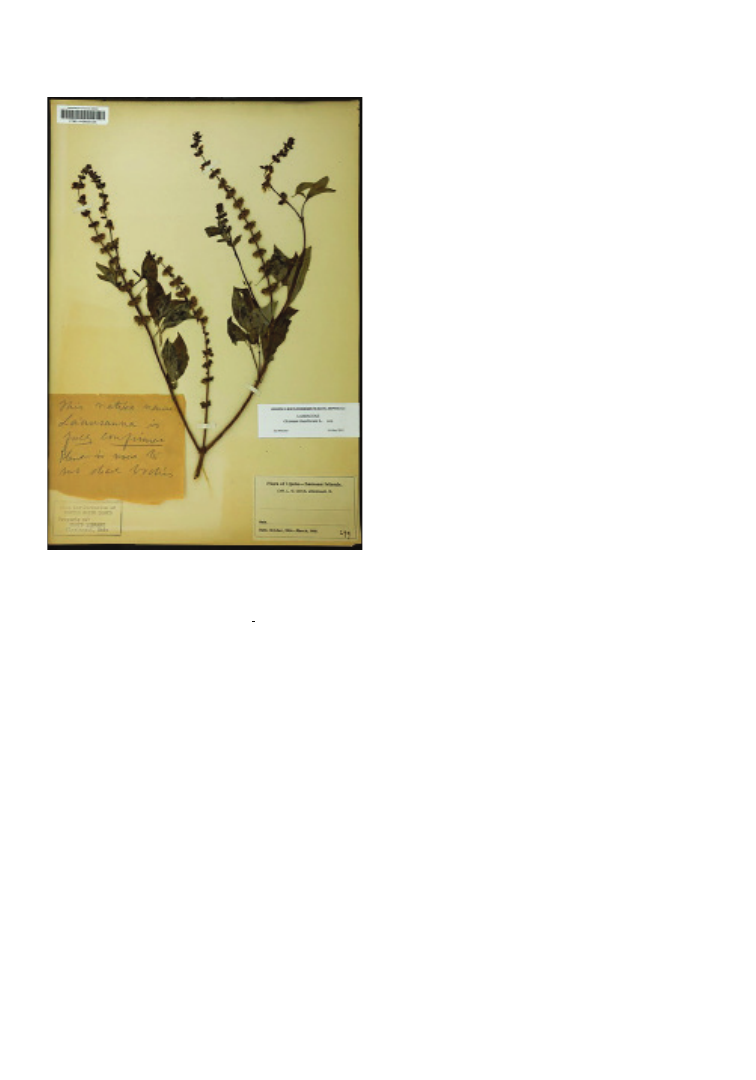
PSB 67 (2) 2021
103
Figure 1.
Specimen of Ocimum basilicum L.
housed at the Margaret H. Fulford Herbarium
at the University of Cincinnati; https://midwes-
therbaria.org/portal/collections/individual/
index.php?occid=15326114&clid=0.
Margaret
H. Fulford Herbarium.
CINC-V-0000103Lloyd,
Curtis Gates 2791904-10-00. Samoa, Upolu,
Upolu, -13.924665 -171.739014.
WHERE IS THE INTEREST
COMING FROM?
How has this gone from an independent
research fellowship to an emerging field with
students and researchers from 20 countries
in 3 years? I think there are a few important
factors:
An Increased Interest
in Plants
The COVID-19 pandemic has no doubt fueled
a lot of change. Many people have been forced
into time at home they didn’t have before.
This time has revealed to a lot of people what
actually makes them happy, how they really
want to live their lives, and what they truly
care about. As a result, many Americans have
discovered a newfound interest in plants.
During the pandemic, houseplants became
an accessible and necessary link between
people and nature. Growers across the United
States have reported a surge in sales through
2020 and the need to eat into 2021’s plant
stock sooner than anticipated (https://www.
greenhousemag.com/article/2021-the-year-
of-flexibility/).
One of the most common things self-reported
by students on my intake survey is the number
of houseplants currently in their homes, or
how large their garden is. It’s not uncommon
for me to have a student with 80+ houseplants
at home.
Changing Views on
Education
In the United States, the way higher education
is perceived and valued is changing, and
I would argue—has changed. Many of my
students come to the School of American
Thanatology to learn about something they
care about as directly as possible. In a way,
there seems to be a prestige—I’m using
actual verbiage from my students here—in
studying with an independent institution like

PSB 67(2) 2021
104
mine. Students want to cut out the middle
man, so to speak, and the middleman is the
“institution.” They want the professor. They
want the person. They don’t want the school.
When I started the school, my big concern
was our lack of accreditation by a larger body.
I didn’t know how I would make time to figure
out which accreditations mattered, let alone
finding the time or resources to devote to those
lengthy processes. I came to find, however,
my students don’t care about accreditation.
They view it as a fee the school likely has to
pay that inflates the cost of education, but as
a professional in the field, I do still care about
it. While leading a young institution, pursuing
accreditation helps me express my care and
value for our work. I value my peers, and I
want my colleagues to trust my commitment.
For those of you reading this with perhaps a
niche knowledge in something plant related,
let this be encouragement to you to try teaching
what you want to teach independently and
directly to the people who want to learn from
you. People want to learn from people with
passion, no matter their home.
WANTING TO TAKE
MORE ACTION
Last year was no joke, and 2021 certainly
isn’t either. Between the political upheaval,
social change, racial injustice, lockdowns and
distancing, 2020 left people asking WHAT.
What can I do, with what I have, where I am?
How can I contribute? How can I have an
impact?
Plants are humanity’s original best friends.
There is an opportunity to take care of ourselves
through the plant–person relationship and our
communities through the plant–community
connection. Many of my students want to
learn how to be in a relationship with plants
again, or maybe for the first time ever.
Thanabotany focuses on not only historical
research, but also what can be done now, where
you already are. We need people recording
their modern-day traditions and rituals with
plants and death now. And we need to collect
specimens alongside our written records.
Thanabotany is a chance to honor, record,
and preserve this relationship and take real,
positive action. People can participate in the
field from wherever they are in the world.
They just need an internet connection.
WHO IS INTERESTED IN
THANABOTANY?
There are two answers here: people who want
to study thanabotany and people who want to
use it.
Based on surveys my students take when they
enroll, my students come from a wide variety
of professional backgrounds. The following
is a selected list of job titles reported by my
students:
• Arborists
• Arboretum professionals
• Artists
• Attorneys
• Board-certified physicians
• Currently enrolled college students
• Educators (K-12 and college)
• Field botanists
• Funeral directors
• Genealogists
• Government workers
• Human resource professionals
• Insurance salespeople

PSB 67(2) 2021
105
• Librarians
• Non-profit executives
• Parks and recreations staff
• Psychiatrists, psychotherapists, and coun-
selors
• Registered nurses
• Retail managers
• Software company executives
• Veterinarians and veterinary staff
• Zoologists
Since 2019, I have kept a list of the inquiries
that come into my website and comments I
get after my talks from people who are seeking
thanabotanical information. Here’s a selected
list of groups/professions who have expressed
a desire to have access to information from
the field of thanabotany for use within their
own contexts:
• Arboreta
• Cannabis and CBD companies/products
• Cemeteries
• Chefs/cooks
• City planners
• Clergy
• Embalmers
• Florists
• Funeral directors
• Gardeners
• Genealogists
• Grievers
• Grocery stores
• Hospices
• Historians
• Horticultural therapists
• Indigenous leaders looking to reconnect
their modern communities to their for-
gotten death practices
• Journalists
• Landscapers
• Nurseries
• Parks and recreation staff
• Sommeliers
• Teachers
• Writers
• Veterinarians
• Zoos
THANABOTANY IN
REAL LIFE: FUNERAL
SERVICE
Louis Linnemann, President of Linnemann
Family Funeral Homes and Cremation Center
in Northern Kentucky said, “When Cole
presented her talk about Thanabotany at the
Annual Meeting of the Northern District of
Funeral Directors and Embalmers, we knew
immediately that the use of flowers and plants
would have an application to funeral service.”
One of their Funeral Directors, Bart Pindela,
was able to immediately take what he learned
about thanabotany at that talk and run with
it. “Thanabotany can provide a meaningful
and memorable connection for families to
their deceased. Plants not only serve as an
expression of sympathy but can be used as a
catalyst for connecting families to the memory
of their deceased,” said Pindela. “Through the
recommendation of the local Thanatologist,
Cole Imperi, I have used rosemary in place
of filler greens in a casket spray. This was
very appropriate because the deceased was
a native of England, where rosemary has a
symbolic and historical connection to funeral
ritual and grief. A few of the rosemary plants
were planted at the graveside and the rest
were taken home by the family to be planted
in their gardens. After the funeral services
were over, a family member thanked me for
recommending the use of rosemary. She said
that rosemary, an herb she overlooked before,
now holds a lasting connection to her mother.
Her comment made me appreciate the
potential of plants to serve families on their

PSB 67(2) 2021
106
path through grief. Plants used during funeral
services are not just expressions of sympathy
but can offer survivors a connection to their
loved ones that continues past the day of the
funeral service.”
This is, in my view, one of the best possible
applications of thanabotany. It provides
additional tools to those in professional roles
(in this case, to funeral directors), and it helps
people move through the grieving process
and find meaning. Research consistently
shows that when we can identify something
with meaning—whether that’s a rosemary
plant or something else—we are likely to live
longer and be healthier. Thanabotany provides
opportunities for plant professionals, as well
as lay people, to find a meaningful role in the
field.
THANABOTANY IN
REAL LIFE: CEMETERY
ARBORETUMS
Did you know that many historic cemeteries
have worked to become arboretums?
Once they “fill up,” they have the time and
resources available to put back into the
landscape. Gertrude Lorenz—an Ecological
Designer, Rewilding Specialist, Certified
Permaculturalist and Board Member at
Historic Linden Grove Cemetery & Arboretum
in Covington, Kentucky—said, “There are
infinite possibilities for Thanabotany at Linden
Grove—from green burials and scattering
gardens to traditional burials and existing
grave sites. Each space is an opportunity for
the use of plants to speak for and about our
loved ones. In addition to the benefit to each
family during the grieving process, it opens
up the wider conversation in the community
about how our natural world has a language
of its own and how it is constantly speaking
to us. It provides a beautifully meaningful
pathway into developing closer relationships
with the individual plants around us which
will ultimately move beyond the cemetery
and flow out into our everyday lives. Nature
is one of our core values at Linden Grove
and many of our current efforts are moving
towards alignment with this value and so
Thanabotany couldn‘t be more on point with
the type of practices we need. Ultimately, it
creates a higher quality experience for our
community and a more refined conversation
around grieving and nature. Thanabotany is
a perfect fit for Linden Grove, but I think it
would be for any cemetery.”
Linden Grove is currently in the process
of installing a thanabotanical garden with
specimens connected to the loss of children
and healing from grief. This includes trees,
shrubs, and flowers with recorded usage
practices related to this specific type of loss
and/or to remedies for grief recovery.
THANABOTANY
ISN’T NEW
Academic and research applications of
thanabotany can provide new ways of looking
at an entire collection, or even a single
specimen. Dr. Eric Tepe, Assistant Professor
and Herbarium Curator at the University of
Cincinnati’s Margaret H. Fulford Herbarium,
pulled a magnificent specimen from their
collection with a special note that would be of
particular interest to a thanabotanist:
“The specimen of basil collected by C.G.
Lloyd in Samoa is interesting for a number
of reasons,” said Tepe. “First, it is native
to Africa and Asia, so probably arrived
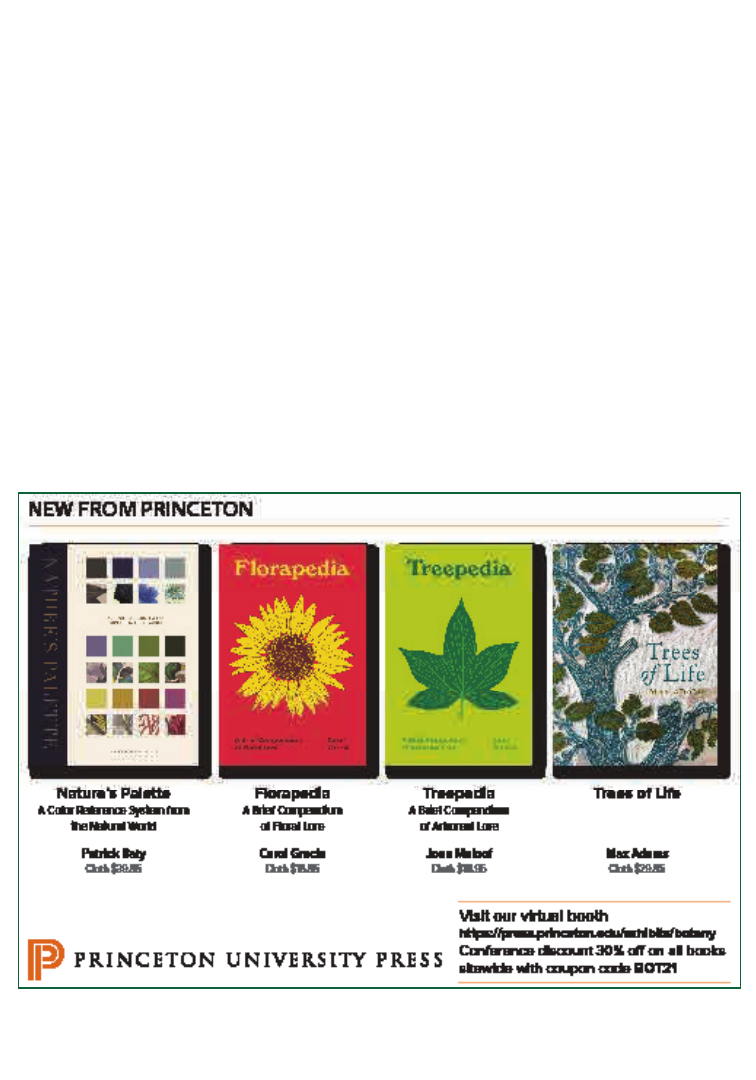
PSB 67(2) 2021
107
in Samoa relatively recently. Its culinary use is obvious, but the fact that it was adopted for
more ritualistic purposes—"rubbing dead bodies”—in that short time is interesting. Lloyd
collected ethnobotanical data for only a few of his Samoan collections, and the extra data that
accompanies this specimen makes it especially valuable. According to Art Whistler’s Plants in
Samoan Culture, coconut oil is used traditionally to absorb plant aromas, which is then used
as a perfume, for massages, and ‘in the past, for embalming the dead.’ He doesn’t comment on
when this practice was abandoned, but the Lloyd specimen could be on the tail end.”
FINALLY
In the last three years, the growth of thanabotany worldwide, without much effort on my part
to market or advertise it, is what has shocked me the most. It doesn’t surprise me, however,
that people are interested. Plants and death are universal experiences. Both are natural. I
look forward to seeing where things are in another three years, and if you read this and find
yourself interested in being a part of an emerging field, please reach out! You can find me at
AmericanThanatologist.com, and you can find the school at AmericanThanatology.com.

PSB 67(2) 2021
108
There are a few things that I particularly enjoy when being a teaching fellow for the class OEB
52 - Biology of Plants at Harvard University: the process of how students gradually became
very familiar with the concept of alternation of generations, the moments when they were
surprised or impressed by random facts of plants, the times when they tell me how they started
to pay more attention to plants around them—and my favorite is when their final creative arts
projects were finally revealed. In this class, we require all students to complete a final creative
project to illustrate the “rise of sporophyte,” and students have their full artistic freedom to
create a project in any form and format. This is definitely the highlight of the class every year,
and we were blown away by their creativity every single time.
We got submissions in songwriting, song adaptations, interpretive dances, yoga lessons,
drawings (watercolor, pencil, vector art, pixel art, sand art—just to name a few), clay art, stop
motion videos, time-lapse videos, song playlists, children’s books, games (e.g., broad games,
online video games), recipe books and menus, magazines, embroidery, puzzles, essays, poems,
and more. A video trailer about the creative projects of the class was made in 2017 and can
be found here: https://drive.google.com/file/d/1EKsgJ_8PEZIVX8-A5dyj1YLaI23BEm4V/
view?usp=sharing.
This year, one of my students, Jude Okonkwo, composed a beautiful poem for his final project,
and I was particularly touched by it. I encouraged him to publish it in the Plant Science Bulletin
because I felt this poem can touch many botanists’ hearts and inspire more people to express
the love and thoughts for botany with arts and literature.
Enjoy! --Min Ya, Harvard University
Poetry Corner

PSB 67(2) 2021
109
Part 2:
Like a sailor who sees in the boundless ocean image
a home
and the weary sojourner
who digs through the desert sands for water I have
sought the shimmers of love’s delightful mirage
Do u grasp too at stones
in hopes of finding a drop of human feeling in this
cold world
Have we not seen what men can do?
how a boy can lie against pavement for nineteen hours
and be left unattended
I often wonder how people mill about knowing that at
any hour their souls can be seized from them
that the oxygen that courses through their blood will
dissipate
leaving behind a temple of tissues, scars and bones
And just like that!
(What is that evolution that pushes this haunting from us?)
But here we are!
(Where in my bones is this escape from fear?)
But I have known the aroma of love just as well
that which dwells like an oracle in the depths of the living
like a shivering fern who hides her child in a
vegetable womb
her lifeblood food for her offspring to eat
like the moss that shrinks the body in a flush of humility
nearing the molecule water that will carry on his
fertile seed
and isn’t that all I desire
that in ages after my body has folded back into soil
that another will arise to roam with a speck
of my heart
that another will love with a hint of my soul
Part 1:
when your bare feet taps against the clovers in the
pavement cracks doesn’t it tear you from the webs of
photography and the allure of lights and guide you to a
more primal home
in the city, do you ever press beyond the concrete
dominion and gaze again at the phantoms of great oak
and bristling vine that once defined our heaven
what does it mean for man to yearn for what cannot
be seen what does it mean for woman to seek what
cannot be understood
I knew a man who sailed a boat to the center
of the Caspian and threw himself into the sea
he said there was pleasure to be found in abandon-
ment in the roar of the water flush against the ears and
the burn of salt scraping up against the skin
was this his atonement for the way we live
a way out of the urges that bind and prod us to build
larger gadgets, larger toys, larger lives as a means of
escape
a botanist taught me that men aren’t the only ones that
seek escape from the body that
sporophytes too push against the structure that God gave
pushing against the body wall, hoarding sunlight and
oxygen
growing further and faster in order to shed parts of
themselves into the wind with hopes of finding refuge
somewhere beyond
In Lasting
By Jude T. Okonkwo
Project Goal: In nature, there is a selective pressure for sporophytes to grow larger in order to
disperse spores by air and a selective pressure for gametophytes to grow smaller to take advantage
of films of water for sperm dispersal. Additionally, heterospory and endospory are traits that
evolved to allow sporophytes to become the dominant generation and these traits have evolved
many times independently. My hope is to explore the question of “lasting” through poetry and
incorporate these physical realities into that poetic endeavor.
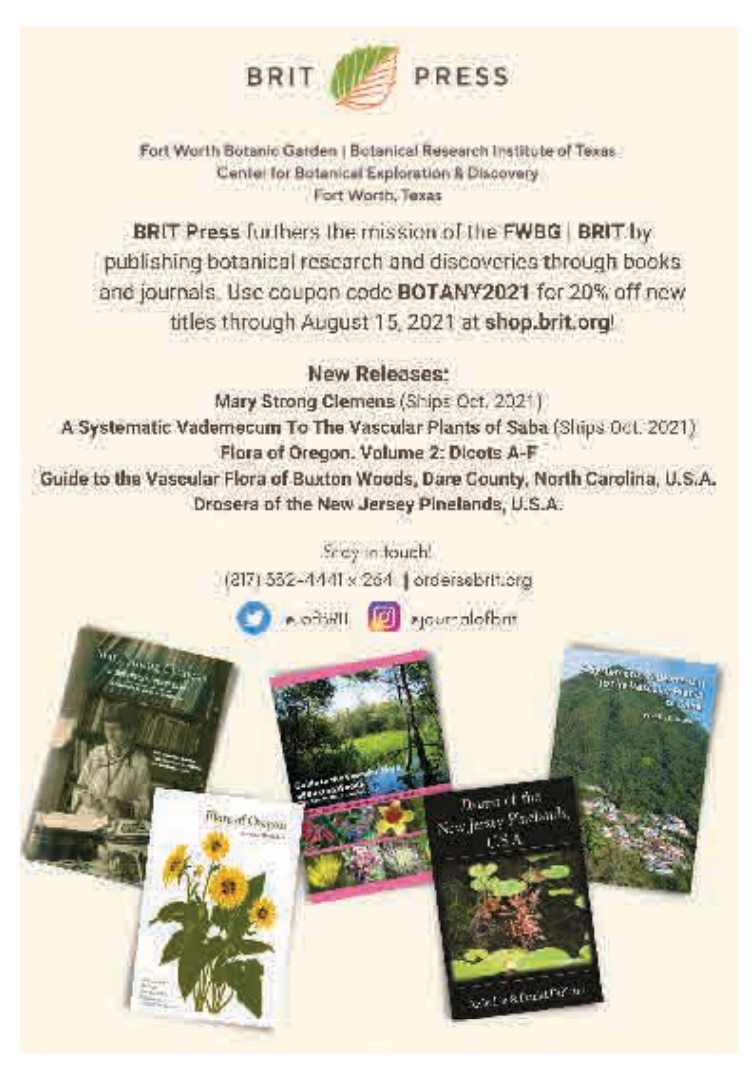
PSB 67(2) 2021
110
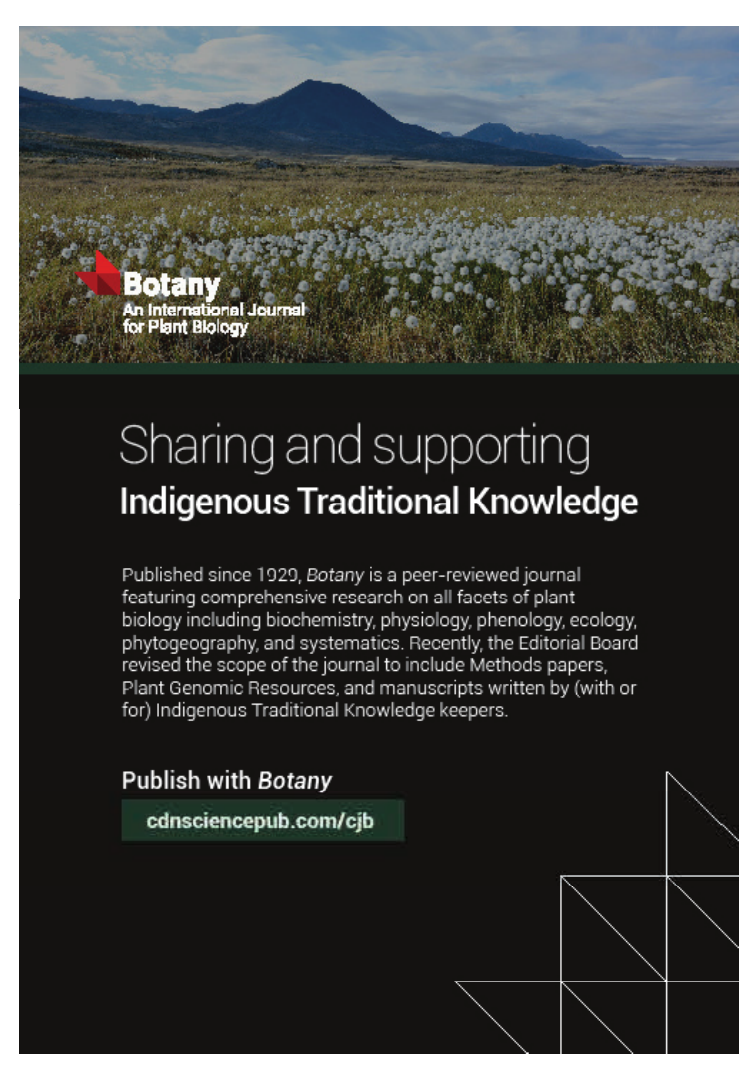
PSB 67(2) 2021
111

112
SCIENCE EDUCATION
By Dr. Catrina Adams,
Education Director
Dr. Jodi Creasap Gee,
Education Technology
Manager
PlantingScience Has Large Session,
Successful Student/Scientist
Mentoring Conversations Despite
Pandemic Disruptions
Despite facing disruptions and a dynamic
range of teaching situations, from fully in-
person learning to hybrid, to fully remote
learning, we had a larger-than-usual spring
PlantingScience session. Nearly 1000 students
from 26 classrooms participated this fall,
working closely with scientist mentors and
our Master Plant Science Team liaisons.
Some student teams worked remotely from
each other, and commented to their scientists
about challenges and lessons learned when
collaborating remotely. “Next time we could
try to check comments and responses of our
group members more often. Most of us used
centimeters, but one or two group members
used inch[e]s.”
Throughout the session, students and scientists
shared a general feeling of optimism and
“light at the end of the tunnel” regarding the
COVID-19 pandemic disruptions, and there
was a lot of appreciation for the motivation
boost of interacting with scientist mentors
virtually, as well as the opportunity to do
science projects again for those participating
virtually.
Explore the PlantingScience Star Project
Gallery at https://plantingscience.org/
psprojects/starprojectgallery to see examples
of the work of PlantingScience student teams
this spring and the conversations they had
with their scientist mentors over the course of
their project.

PSB 67(2) 2021
113
SEEKING 20 GRADUATE
STUDENTS &
POST-DOCTORAL
RESEARCHERS FOR
PLANTINGSCIENCE
MASTER PLANT
SCIENCE TEAM
“Being part of the Master Plant Science Team
was a great entry point for me to start mentoring
an age group I don’t normally interact with.
Their curiosity and engagement with their
experiments was fantastic to see, and it was also
a good chance for me to practice communicating
my research in a broadly accessible way.”– Greta
Rockstad, PlantingScience Liaison
Are You Ready to Be
More Than a
PlantingScience Mentor?
Graduate students and post-doctoral
researchers: does mentoring with
PlantingScience sound exciting to you? Do
you have good communication skills already
and some experience with or a strong interest
in helping secondary students and teachers?
If so, consider serving as a teacher/scientist
liaison as part of our Master Plant Science
Team. We provide training in what it takes to
excel as an online mentor and reveal behind-
the-scenes aspects of how the program works.
First, you’ll get to mentor several teams to
learn the ropes and practice mentoring with
diverse groups of students.
Then you are paired with one of our
participating teachers to help the teacher
get the most from the program, make sure
the teacher’s mentors get the classroom and
scheduling context they need to be good
mentors, and help to keep the student/
scientist conversations going strong. It is an
excellent opportunity to see how a variety of
mentoring styles play out with students and
a powerful way develop your own mentoring
and communication style. Liaisons make the
program possible!
In exchange for your extra help, we sponsor
your BSA membership for the year and provide
a 50% discount off of meeting registration.
Learn more and apply by August 16, 2021 at
https://plantingscience.org/joinmpst.
LIFE DISCOVERY: DOING
SCIENCE CONFERENCE
To Be Held In-Person at
Estes Park, CO,
Sept. 30–Oct. 2, 2021
The 7th Life Discovery – Doing Science
Conference (esa.org/ldc) will be held in
person in September, and we are still accepting
Education Share Fair Roundtables. Check the
website for details on the COVID-19 policy
for the conference.
This stand-alone education conference—co-
sponsored by the Botanical Society of America
along with the Ecological Society of America
and the Society for the Study of Evolution—
is for high-school teachers, informal science
educators, program coordinators and
directors, lecturers, and faculty who teach
organismal or environmental biology.
BE MORE THAN A
MENTOR
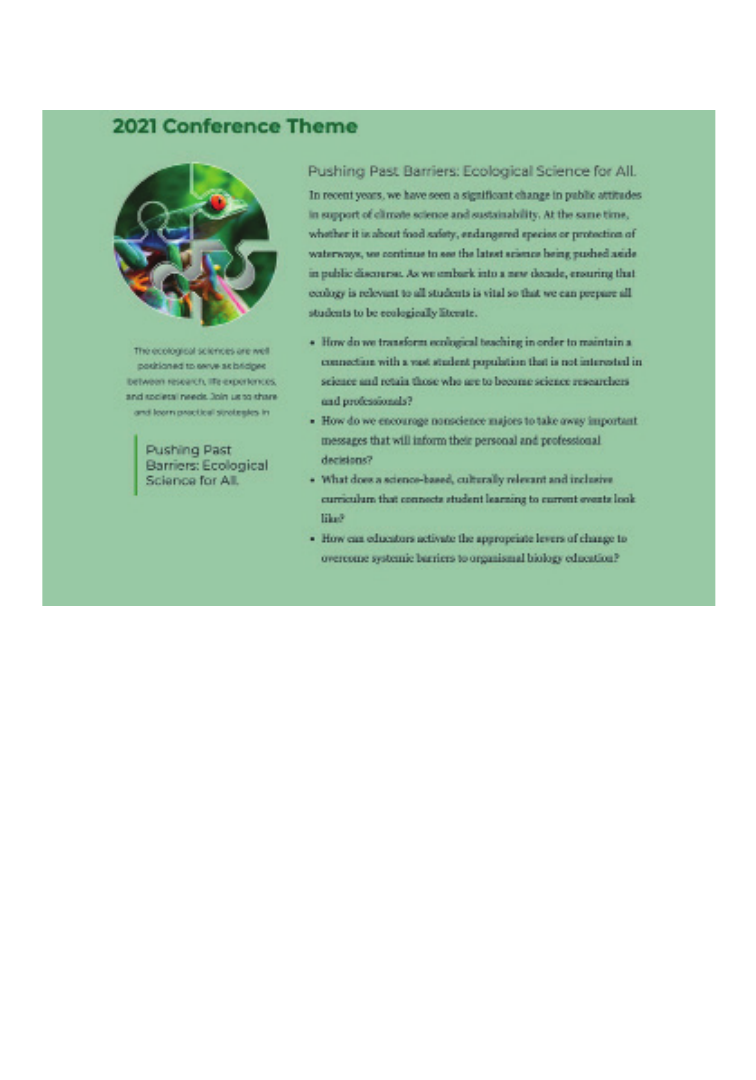
PSB 67 (2) 2021
114
This year’s theme is “Pushing Past Barriers:
Ecological Science for All.” Taking advantage
of the YMCA of the Rockies location, the
conference will offer three pre-conference
field trip options, including a hands-on
workshop (EREN-NEON Flexible Learning
Projects – Building skills in field ecology
and data science) and two trips (National
Ecological Observatory Network’s (NEON)
Rocky Mountain National Park terrestrial
field site and the Boulder Apple Tree Project
– Exploring techniques and practices
of community-engaged undergraduate
research).
The Life Discovery Conference is a great place
to meet other educators. The discussion-heavy
conference format, high ratio of presenters to
attendees, and small (~100) size allows for
great networking and deep conversations
about the best ways forward in organismal
biology science education. It draws a diverse
group of educators, which adds to the richness
of discussion by bridging perspectives across
the worlds of university, high school, and
informal education. We hope you can join us!

PSB 67 (2) 2021
115
Looking forward to seeing
many of you
at these conference
sessions!
Tuesday June 15
1:00 PM EDT: Pre-conference workshop:
Ace it! Practice, Get Feedback, Give a Better
Talk
(This session was recorded and will be
available on the conference platform for
registered attendees.)
Sunday, July 18
1:00 PM EDT: Workshop: Challenges
and successes of research at primarily
undergraduate institutions: Jumpstarting
your 2021-2022 research program
1:00 PM EDT: Workshop: Tips for Success:
Applying to Graduate School
3:00 PM EDT: Primarily Undergraduate
Institution Section Business Meeting
Monday, July 19
12:00 PM EDT: Careers in Botany Luncheon
3:00 PM EDT: Plenary Address: From Seeds
of Change to a Harvest of Discovery, Beronda
Montgomery
4:00 PM EDT: SciComm Celebration Day
Mixer
6:00 PM EDT: Student Social and Networking
Event
Tuesday, July 20
12:30 PM EDT: Contributed Paper Session
Education and Outreach I: Botany for
Diverse Audiences and Under-Resourced
Communities
3:00 PM EDT: Belonging in Botany Special
Lecture: Perspectives on DEI, David Asai
4:00 PM EDT: Belonging in Botany Discussion
5:00 PM EDT: Education and Outreach Poster
Session
Wednesday, July 21
10:00 AM EDT: Contributed Paper Session
Education and Outreach II: Engagement,
Communication, and Teaching Tools
12:00 PM EDT: BSA Teaching Section
Business Meeting
1:00 PM EDT: Contributed Paper Session
Education and Outreach III: Teaching Tools,
Laboratories and Research Experiences
EDUCATION FEATURES AT BOTANY 2021 VIRTUAL!
Consider attending some of the many education, outreach, and training opportunities:

116
STUDENT SECTION
By Shelly Gaynor and Imeña Valdes
BSA Student Representatives
Graduate School Advice
Since the summer is a time of transition and many of you may be starting graduate programs
soon, we decided to collect some general advice on succeeding in graduate school. Often
graduate school–related advice focuses on how to get into programs, rather than how to succeed
in them. Here we focus on how to flourish in graduate school. The advice shared below, by BSA
members (in quotes), focuses on balance, support systems, planning ahead, and taking care of
yourself.
BALANCE
SUPPORT
PLANNING AHEAD
FIND BALANCE
Graduate school can often feel like a never-
ending marathon. It’s important to learn how
to set boundaries, find work–life balance,
and recharge. This may look different for
everyone: some people may work great
during typical work hours, while others may
work great from noon to 1 a.m. Find what
works for you!

PSB 67(2) 2021
117
(Summerville et al., 2021). It is also important
to learn when to say “yes”—specifically, what
drives you and what you enjoy. Graduate school
is a great time to explore and define your interests.
GET A SUPPORT SYSTEM
Reach out to find supportive friends and be nice!
Dr. Karolina Heyduk
University of Hawaiʻi at Mānoa
“
Get a squad of peers, people who you
feel comfortable with and enjoy spending
time with. It'll be so important to have
that support system through grad school,
and helps you reframe the grad school
dynamic into mutual support, rather than
competition.”
Anonymous
“(1) Invest in relationships with people,
in and out of your program. Have a
support network that you can be honest
and vulnerable with. (2) Corollary: don't
**** where you eat. You may be entering
lifelong professional relationships with
your colleagues. Try not to be out of
control or mean or toxic around them.
Exercise judgment about how open you
are and with whom. Treat the people
around you well. Everyone is smart, so
distinguish yourself by being kind.”
HOW TO MAKE FRIENDS
IN GRADUATE SCHOOL
• Join clubs, sports teams, or other organi-
zations in your new city to meet people
outside of your program.
Dr. Chris Martine
Bucknell University
“Treat it like a job. Come in every day and
work your hours like it’s a real job. You will
be more efficient and more productive ...
and you will also be able to set boundaries
on your time that will allow for the sort
of work–life balance that promotes good
mental health. If you don’t develop that
habit in grad school, there’s a decent
chance you might never do so.”
Dr. Karolina Heyduk
University of Hawaiʻi at Mānoa
“Make time for you. Hobbies, family,
friends. It's so easy to get wrapped up into
the "I have to work all the time!" aesthetic
of academia, but no good will come of
that. Prioritize things that make you
happy (hopefully your research is one of
those things!).”
Anonymous
“Figure out what is most essential to
recharge your batteries—sleep, exercise, a
special hobby—and protect it fiercely. Set
boundaries, because grad school does not
respect your time.”
Prioritize your tasks and break them down
into smaller, more achievable goals (Lewis Jr.
et al., 2019). Check out the Summer 2020 PSB
issue for time management strategies.
Learn how to say “no”! This is a really
important skill to gain during graduate school.
It is recommended to think carefully before
saying “yes” by consulting mentors or peers
and weighing your current commitments

PSB 67(2) 2021
118
• Check if your university has a BSA student
chapter; if not, think about starting one!
• Join the BSA Slack and interact with BSA
members on Twitter!
• Attend the Botany Student Socials!
PLAN AHEAD
Dr. Karolina Heyduk
University of Hawaiʻi at Mānoa
“Start thinking about the future (and your
next career step) earlier than you think
you should. That final defense will come
fast, and it's good to be prepared.”
Anonymous
“Two things I have learned are important,
(1) have a 5-year and 10-year plan.
These can change and be flexible, but
planning for the future and thinking
about it often is a helpful tool when
choosing what project/side projects
will help you accomplish those goals.
(2) Learn to market yourself and your
research. It takes practice and skill to talk
to journalists in helpful ways that enable
them to share your research.”
EXPLORE DIFFERENT
CAREER PATHS
• Attend the Careers in Botany Luncheon
at annual Botany meetings.
• Check the BSA Virtual Networking
Board for different opportunities.
• Check out the Spring 2021 PSB issue for
internship and job-related resources.
TAKE CARE OF
YOURSELF
COVID-19 has worsened the mental health
crisis that already existed in academia. It is
important to understand your limitations
and take breaks when necessary. Seeking help
from a professional or online resources can
provide support during your time in graduate
school (find a list of resources in the Fall 2020
PSB).
Anonymous
“Posturing behavior is common and
it’s easy to feel like an imposter in this
environment. Understanding this
might’ve helped me feel ‘sufficient’ during
grad school.”
Being open to being wrong and not taking
criticism personally will help you succeed in
an academic environment (Cummingham
et al., 2021). In academia, you are always
learning; the more you know, the more you
feel like you know nothing. Receiving a
document back covered in corrections may
sting a little at first, but your advisor and
other mentors are there to help you grow
and provide new insights through those
corrections. Take everything in stride and
learn from your mistakes.
LITERATURE CITED
Cummingham, W. A., J. J. Van Bavel, N. A.
Lewis, and J. Gruber. 2021. Science relies on
constructive criticism. Here’s how to keep it
useful and respectful. Letters to Young Sci-

PSB 67(2) 2021
119
entists. doi:10.1126/science.caredit.abi6902.
Lewis Jr., N.A., L. H. Sommerville, J. J. Van Bavel, J. Gruber, and W. A. Cunningham. 2019.
Step back to move forward: Setting new priorities in the new year. Letters to Young Scientists.
doi: 10.1126/science.caredit.aaw5301.
Sommerville, L. H., J. J. Van Bavel, N. A. Lewis, J. Gruber, and W. A. Cunningham. 2021.
Learn when—and how—to say no in your professional life. Letters to Young Scientists.
doi:10.1126/science.caredit.abg4310.
PAPERS TO READ FOR FUTURE LEADERS
As we continue in our careers, we hope to see the academic culture shift to be healthier and
more inclusive. Below are a few papers we think you should read if you hope to lead. We hope
to continue to recommend “Papers to Read for Future Leaders” to BSA Student members; if you
have papers you would like us to include, please share it with us via this Google form: https://
tinyurl.com/y5dp8r4m.
• Cooper, K. M., A. J. J. Auerbach, J. D. Bader, A. S. Beadles-Bohling, J. A. Brasshears, E.
Cline, S. L. Eddy, et al. 2020. Fourteen recommendations to create a more inclusive en-
vironment for LGBTQ+ individuals in academic biology. CBE - Life Science Education
19:es6: 1-18.
• Chaudhury, A., and S. Colla. 2021. Next steps on dismantling discrimination: Lessons
from ecology and conservation science. Conservation Letters 14: e12774.
• Claire Demery, A. J., and M. A. Pipkin. 2021. Safe fieldwork strategies for at-risk individu-
als, their supervisors and institutions. Nature Ecology & Evolution 5: 5-9.
• Nocco, M. A., B. M. McGill, C. M. MacKenzie, R. K. Tonietto, J. Dudney, M. C. Bletz, T.
Young, and S. E. Kuebbing. 2021. Mentorship, equity, and research productivity: lessons
from a pandemic. Biological Conservation 255: 108966.
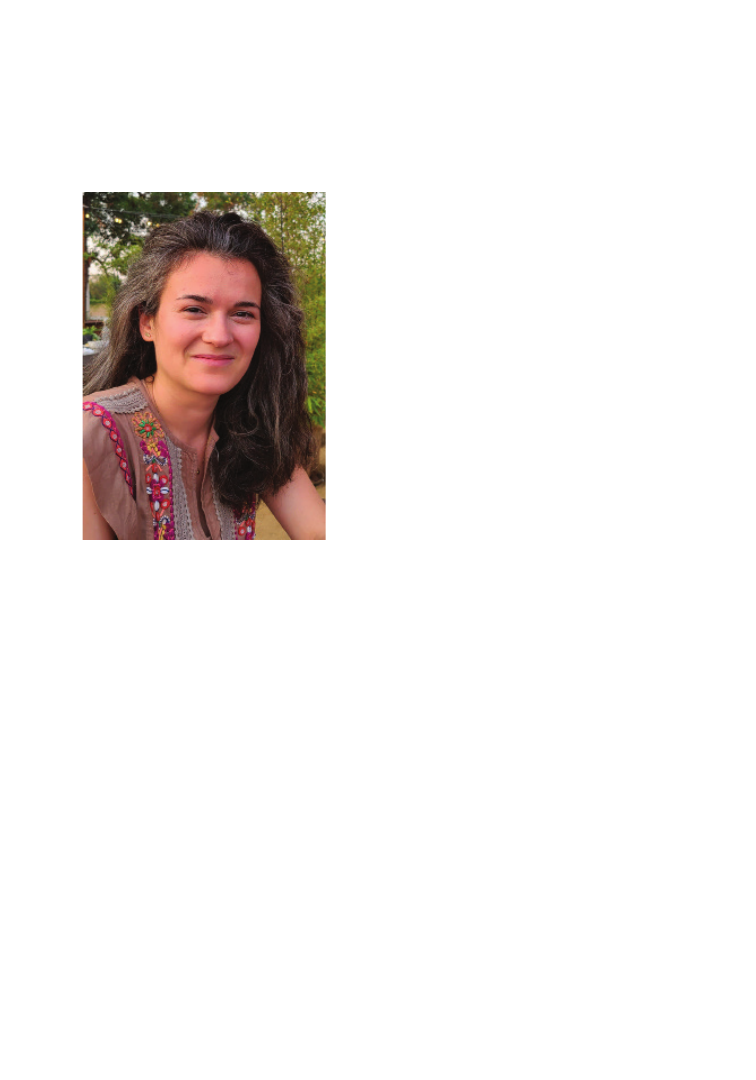
PSB 67(2) 2021
120
GETTING TO KNOW
YOUR NEW STUDENT
REPRESENTATIVE
IOANA ANGHEL
University of California,
Los Angeles
When did you join BSA and what motivated
you to do so? Will you encourage other
students to become members and participate
in the Society as well?
I joined BSA as a first-year graduate student
in 2018 when my advisor, Dr. Felipe Zapata,
sponsored my membership. I was excited to
join to get to know a broader community
of botanists outside of my home and local
institutions. I am looking forward to learning
what motivates students to join a Society,
and to encourage students to be active in
the Society by reflecting their motivations
through BSA activities and programming.
What motivated you to run for the position
of Student Representative to the Board of
Directors, and what do you plan to do as the
student representative of BSA?
I was so impressed by the student reps I met
at the Botany Conference in 2019. Minya
and Chelsea Pretz were an inspiration—they
helped students feel connected by being
present and checking in. They created a sense
of community and made me feel included and
welcome. The student-centered events they
planned and managed were intentional and
meaningful, like the Student Luncheon where
professionals shared how they leveraged their
botany education into successful careers. I
wanted to help continue these traditions, as
well as try to enhance student participation
through additional activities and projects.
As the BSA student representative, I would
love to develop a program to help students
find potential collaborators through activities
that encourage open idea generation and low-
stakes discussions. This would look like a space,
either virtual or at the Botany Conference,
where students can openly discuss ideas
and interests and find other people who are
excited about similar topics. Formalizing such
a space would hopefully energize and motivate
students to become involved with other BSA
initiatives and connect with both plants and
plant people. I believe students thrive when
they trust that their short experience is still
valued and nurtured by the other members
of the community. To support this, I would
like to formalize a way for students to connect
with other botanists with common interests
and with people who can expand their sense
of possibility in botany.
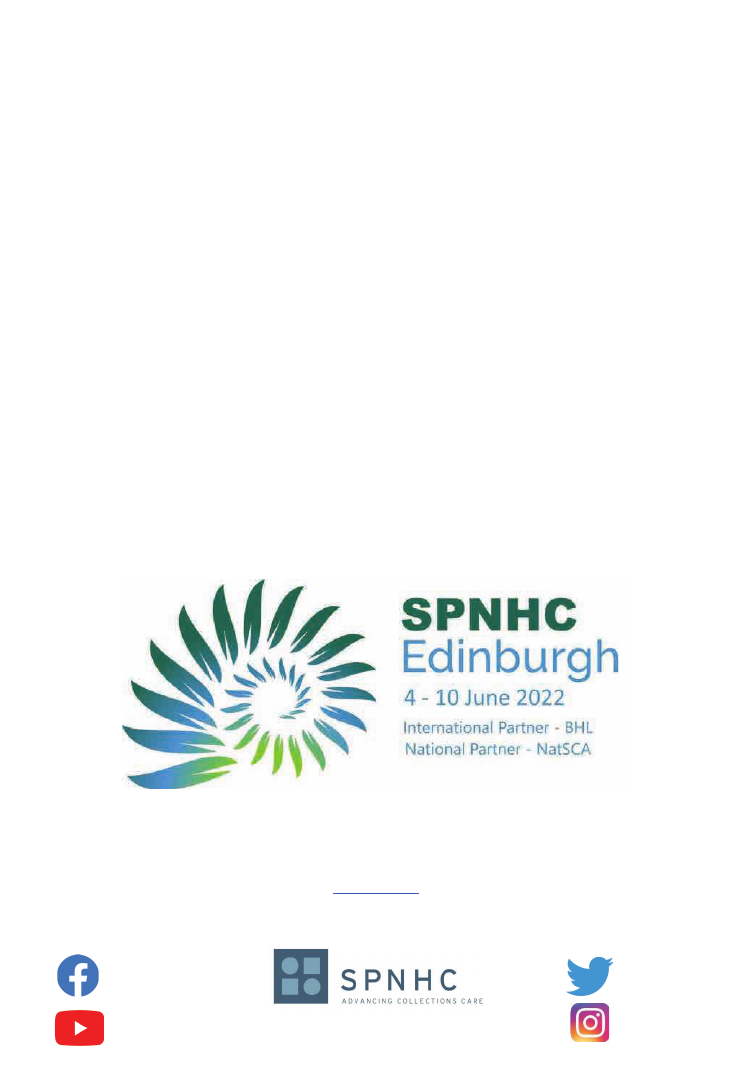
PSB 67(2) 2021
121
What have you gained from being a student member of BSA, and why would you encourage
other students to become members and participate in the Society?
Finding mentors and friends working with plants is so important in encouraging early botanists
to identify their interests and strengths. BSA is an organization that helps me foster my interests
through creating a sense of community and helping connect members with opportunities to
develop their skills, network, and sense of possibility for their work.
What’s your research about, and how did you discover your research interest?
I study the evolution of species in Linanthus, a group of diverse annual ephemeral plants with a
center of diversity in the Southern California. I am reconstructing the phylogeny of the group,
including both genomic and morphological data, and looking at the role of floral scent in
differentiating co-occurring species in sympatry. I think annual desert plants are a fascinating
and underappreciated group of organisms, and I am hoping that my research can help reveal a little
more of their magic.
What sorts of hobbies do you have?
I love anything outdoors, cultural or crafty. I’m Romanian and I enjoy learning traditional skills,
like painting eggs in the batik style for Easter or sewing and embroidering traditional clothing.
I also have many indoor plants and love to spend long periods of time watering them and
observing changes, and I answer questions about plant care from my friends.
Society for the Preservation of Natural History Collections
Join our global community dedicated to the preservation, conservation
and management of natural history collections
spnhc.org
SPNHC 2022: hosted by Royal Botanic Garden Edinburgh and National Museums Scotland, UK
SPNHC 2023: hosted by California Academy of Sciences, San Francisco, USA, May 28-June 2, 2023
“It’s pronounced “SPINACH!”
spnhc
_
;@SPNHC
;@www.spnhc.org
SPNHC
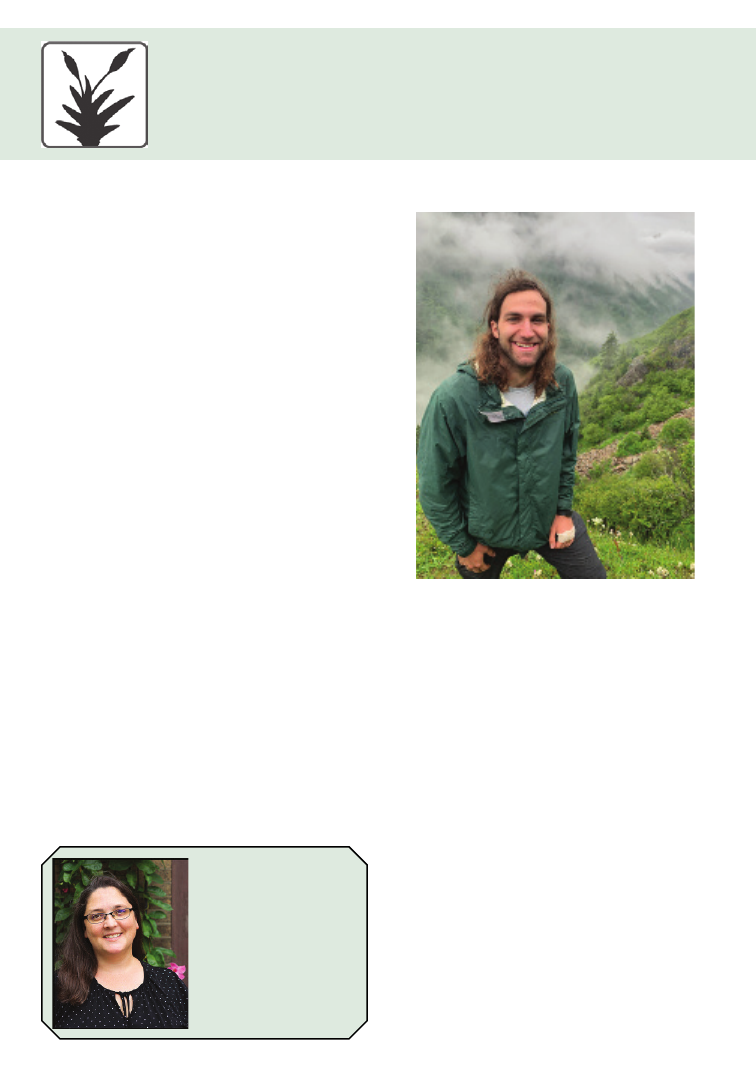
122
REFER A PROFESSIONAL
Do you know a Professional in the plant
sciences that would benefit from being in
the BSA community? Our summer “Refer a
Professional” member program introduces
professional plant scientists to the benefits
of BSA and offers them a one-time discount
of 20% off an annual membership. To refer a
professional, email me at aneely@botany.org
with their information and I will send them
the information. Referrals must come from
current BSA members, and the professionals
must be new to BSA.
MEMBERSHIP NEWS
By
Amelia Neely
BSA Membership &
Communications
Manager
E-mail: ANeely@</a>
botany.org
BSA LEGACY SOCIETY
The intent of the Botanical Society of
America’s Legacy Society is to ensure a
vibrant BSA for tomorrow’s botanists and
to assist all members in providing wisely
planned giving options. All that is asked is
that you remember the Botanical Society of
America as a component in your legacy gifts.
It’s that simple—no minimum amount, just
a simple promise to remember the Society.
We hope this allows all BSA members to play
a meaningful part in the Society’s future. To
learn more about the BSA Legacy Society and
how to join, please visit: https://botany.org/
home/membership/the-bsa-legacy-society.html.
THANK YOU, JARED!
Jared Meeks was one of two original BSA
Student Social Media Liaisons, and has been
working with us since October 2019. His two-
year term will be up this September and we
are thankful for the lasting impact that he has
had on BSA and our social media presence.
Jared was in charge of the BSA Twitter
account, and created interesting content
such as Morphology Monday. He also helped
to create the BSA Liaison Handbook that
houses important information for future BSA
liaisons. In his role, Jared worked with BSA
staff, student representatives, and the Early
Career Advisory Board (ECAB) to coordinate
daily posts, Twitter Takeovers, and the
popular SciComm Celebration at the Botany
Conferences.

PSB 67(2) 2021
123
When he started, Jared was a Master’s
student studying the Pedicularis genus in
the mountains of southwest China. While
working for BSA, he received his Master’s
degree, had a daughter, and started his PhD
program at Columbia University, where
he has expanded his research to compare
processes of flowering plant speciation in
multiple temperate mountain systems across
Asia and North America. He plans to continue
teaching, researching angiosperm evolution,
and fostering greater care and concern for
mountain biodiversity throughout his life.
SPOTLIGHT SERIES
The BSA Spotlight Series, created and run
by the BSA Student Social Media Liaisons,
highlights early career scientists in the BSA
community. Scientists’ profiles are shared
on all BSA social media platforms, the BSA
eNewsletter, and housed on the BSA website.
The Spotlight Series shares both scientific
goals and achievements, as well as personal
interests of the scientists, so you can get to
know your BSA community better.
Are you an early career scientist, or do you
know an early career scientist that we should
highlight in our Spotlight Series? Fill out the
simple form at https://bit.ly/3dkfWtj. This
opportunity is open to current early career
BSA members.
STUDENT CHAPTERS
BSA currently has 23 active Student Chapters!
Student Chapters are a great way for students
to network with their peers at their institution
of learning through engaging activities as well
as to take advantage of special BSA discounts,
including a $10 Student Membership and
greatly discounted registration to Botany
Conferences each year. To learn more out
current student chapters, or how to start your
own student chapter, visit: https://botany.org/
home/membership/student-chapters.html.
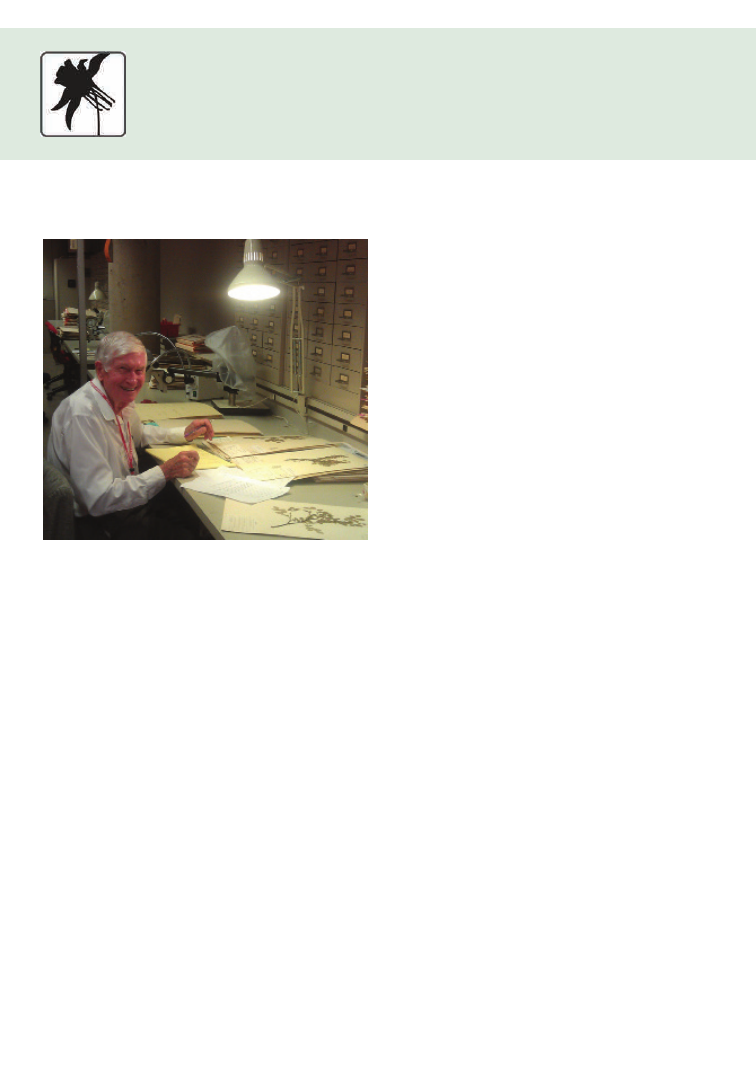
124
ANNOUNCEMENTS
In Memoriam
With the passing of Dr. Walter H. Lewis
on 17 November 2020, the world has lost
a great biologist, and each of us who knew
and treasured him has lost a dear friend and
valued colleague. Walter Hepworth Lewis was
born in Carleton Place, Ontario, Canada on
26 June 1930, and grew up in Victoria, British
Columbia. He showed an early interest in plants
and the natural world. He told his father that
he wanted a greenhouse for his 12th birthday,
and his father gave him one. His uncle taught
him how to grow roses from cuttings, and that
was the beginning of a lifelong fascination
with and dedication to the genus Rosa.
Over his lifetime he amassed a huge living
collection of wild rose species, mostly from
North America, which he maintained partly
WALTER LEWIS
(1930–2020)
at his home and partly in various scientific
and horticultural institutions, including the
Missouri Botanical Garden. His decades-long
taxonomic and cytological study of North
American Rosa culminated in the treatment
of Rosa in the Flora of North America (Lewis
et al., 2015), co-authored with Barbara Ertter
and Anne Bruneau, with the entire volume
dedicated to him. Subsequent publications
dealt with natural North American rose
hybrids and described the new species Rosa
memoryae in honor of his wife and lifelong
research partner Dr. Memory P. Elvin-Lewis
(Lewis, 2016), and detailed chromosome
variation within the worldwide Rosa acicularis
complex (Lewis and Elvin-Lewis, 2017). His
contribution to the scientific understanding
of wild roses cannot be overestimated, yet it is
only one aspect of his exceptionally long and
productive career.
Walter completed his PhD in Biology at
the University of Virginia in 1957 under
the guidance of Walter S. Flory, Jr., with a
monograph of Rosa in North America east of
the Rocky Mountains. He then taught biology
for four years at Stephen F. Austin State
College (now University) in Nacogdoches,
Texas. He took a leave of absence after being
awarded a grant from the National Science
Foundation for study in Europe and Africa,
and then a Guggenheim Fellowship to study
palynology. For two years he worked in the
Herbarium of the Royal Botanic Gardens,
Kew, at the University of Leeds, and at the
Swedish Academy of Sciences in Stockholm
with Professor Gunnar Erdtman. During
this time, he also made a six-month field
expedition by Land Rover in Africa to collect

PSB 67(2) 2021
125
cytological materials for studies of Rubiaceae,
traveling through Kenya, Tanzania, Zambia,
and South Africa under difficult logistical
conditions and in unstable political times. This
work focused on Rubiaceae, and he remained
a leading specialist in the family throughout
his career. Returning to North America, he
accepted a joint position with the Missouri
Botanical Garden and Washington University
in St. Louis. He was Curator and Director of
the Missouri Botanical Garden Herbarium
(MO) from 1964 to 1972.
Walter arrived at the Garden during a period
of transition following the death in 1963 of
Robert Woodson, the previous Herbarium
Director. The following year Dr. David M.
Gates arrived as the Garden’s new Director.
Walter immediately began to institute changes
that revitalized the Garden’s programs and set
them on new courses that continue until this
day. He revitalized publication of the Annals
of the Missouri Botanical Garden in 1964. He
restarted and invigorated the Flora of Panama
project, which had lapsed with Woodson’s
death, instituted a permanent field station
in Panama, and founded the herbarium at
the Smithsonian Tropical Research Institute
(SCZ) in Balboa, Panama. He obtained funds
from the Smithsonian Tropical Research
Institute and Washington University to
create a new position to write the Flora of
Barro Colorado Island, and in 1967 hired
Thomas B. Croat, still on the Garden’s staff,
to do the job. He reached an agreement with
other major herbaria in North America and
Europe that the Missouri Botanical Garden
would act as the primary North American
repository for African plant collections
(Lewis, 1970), which quickly led to a large
inflow of African specimens that provided
the groundwork for the Garden’s present-
day Africa and Madagascar Department and
related programs.
At Walter’s initiative, the Garden established
a consortium with Washington University,
Saint Louis University, the University of
Missouri at St. Louis, and Southern Illinois
University at Edwardsville to identify core
areas of specialization of each institution and
allocate them so that students could obtain
the best possible botanical education, with the
Garden as the focal institution. One feature
of that training was the initiation of a weekly
plant taxonomy seminar for staff and students,
which continues today—more than 50 years
later!—as the Floristic Taxonomy Seminar on
Fridays. Based on an October 1990 celebratory
event at the Garden occasioned by Walter’s
60th birthday, D’Arcy et al. (1992) published a
detailed and moving tribute to him.
Walter’s career in the Department of Biology
at Washington University began in 1964 at
the same time as his work at the Missouri
Botanical Garden, and never really ended
during his lifetime; on a website dated 14 May
2020, his status is still listed as “semi-retired”.
He was a gifted and very popular teacher of
undergraduate students, with his Medical
Plants course having the highest enrollment
of all the upper-level undergraduate courses
offered by the University. His extremely
effective lectures about the ethnobotany of the
Achuar Jívaro people of Amazonian Ecuador
and Peru drew upon his collaborative work
with Memory Elvin-Lewis, which generated
massive plant collections and ethnomedical
data from areas with little or no previous
botanical exploration. Their rigorously
scientific book Medical Botany: Plants Affecting
Man’s Health (Lewis and Elvin-Lewis, 1977,
2003) is still a definitive work on traditional
pharmacopeias and their relevance to modern
life. They developed a set of practices for
ethical use of traditional knowledge as part of
their field work, which became the standard
for other projects and an element of today’s
intellectual property bioethics.

PSB 67(2) 2021
126
Walter’s accomplishments and contributions
are far too many to detail exhaustively here.
His outstanding work in cytology and its
relevance to plant function is well exemplified
in the pioneering congress on polyploidy
held in 1979 at Washington University. This
brought together systematic and agricultural
scientists for the first time, and resulted in a
book summarizing the results of the congress
(Lewis, 1980), as well as an ongoing series of
international conferences on this area. His
expertise in palynology led him to research
and publication on aeroallergens (e.g., Lewis
et al., 1983). Walter also found time to work
with the taxonomy of wild ginseng (Panax
quinquefolius) and design of a conservation
program for it in Missouri (e.g., Wilson and
Lewis, 1980). His many graduate students
include outstanding leaders in botany and
various related fields, and he has an impressive
set of career awards and honorary degrees.
Walter contributed much to science, and also
to humanity. Above all, we remember Walter
as a kind and thoughtful friend and colleague
who always thought of others’ needs in the
midst of his own dynamic and brilliant life.
Sally Bommarito, a plant mounter at the
Missouri Botanical Garden, remembers one
Valentine’s Day when he brought the Garden’s
plant mounters chocolate truffles and folders
of rose specimens (of course they were roses!)
to mount. He will not be forgotten by those
who knew him, and his legacy of scientific
contributions will continue to influence and
inform us.
LITERATURE CITED
D’Arcy, W. G., J. W. Nowicke, and K. R. Rob-
ertson. 1992. Introduction, A tribute to Wal-
ter H. Lewis. Annals of the Missouri Botanical
Garden 79: 1-7.
Lewis, W. H. 1970. Missouri Botanical Gar-
den as repository of African material in North
America. Taxon 19: 345-346.
Lewis, W. H. 1980. Polyploidy: Biological Rel-
evance. Plenum Press, New York.
Lewis, W. H. 2016. Nomenclatural novelties in
Rosa (Rosaceae) subgenus Rosa recognized in
North America. Novon 25: 22-46.
Ph
oto
C
ou
rte
sy
o
f M
iss
ou
ri B
ota
ni
ca
l G
ar
de
n
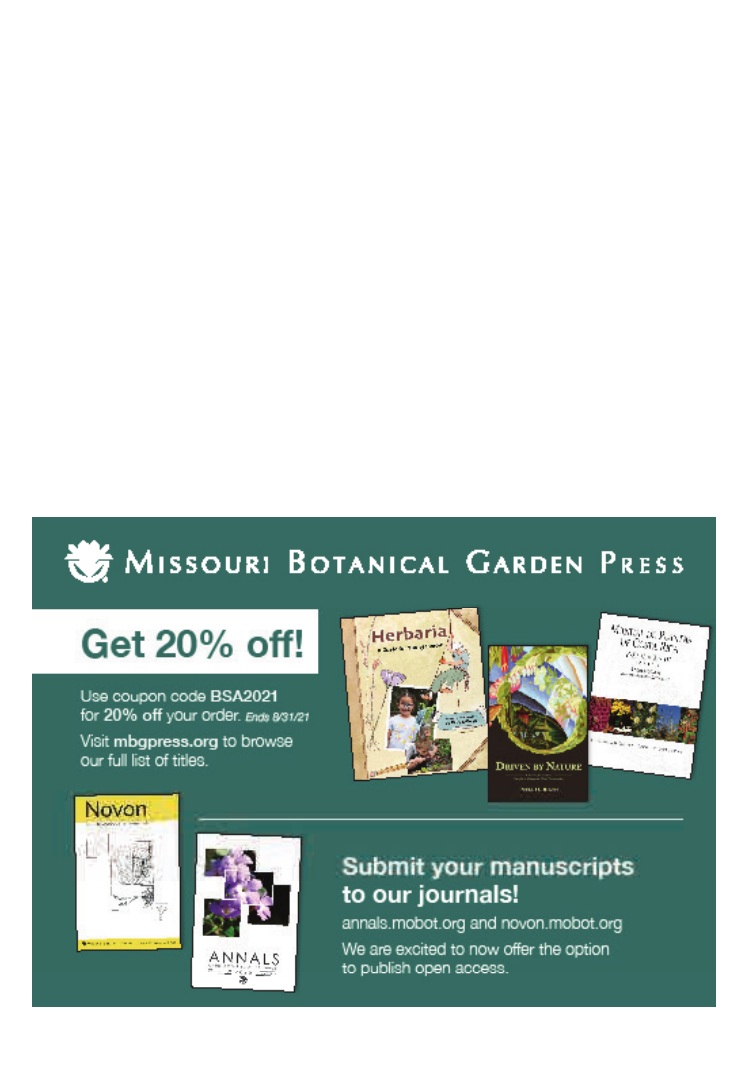
PSB 67(2) 2021
127
Lewis, W. H. & M. P. F. Elvin-Lewis. 1977. Medical Botany: Plants Affecting Man’s Health. John
Wiley & Sons, New York.
Lewis, W. H., P. Vinay, and V. E. Zenger. 1983. Airborne and Allergenic Pollen of North America.
Johns Hopkins University Press, Baltimore, MD.
Lewis, W. H. and M. P. F. Elvin-Lewis. 2003. Medical Botany: Plants Affecting Man’s Health, ed
2. John Wiley & Sons, New York.
Lewis, W. H., B. Ertter and A. Bruneau. 2015. Rosa. In: Flora of North America Editorial Com-
mittee (editors), Flora of North America North of Mexico 9: 75-119. New York and Oxford.
Lewis, W. H. and M. Elvin-Lewis. 2017. The worldwide significance of karyotypic variation in
Rosa acicularis. Journal of the Botanical Research Institute of Texas 11: 433-454.
Wilson, J. H., and W.H. Lewis. 1980. The Missouri ginseng conservation program. In: Proceed-
ings of the First International Ginseng Congress, pp. 35-42. Lexington, KY.
-Roy E. Gereau, Charlotte M. Taylor, Thomas B. Croat, Peter C. Hoch & James S. Miller
Missouri Botanical Garden, 4344 Shaw Blvd., Saint Louis, Missouri 63110
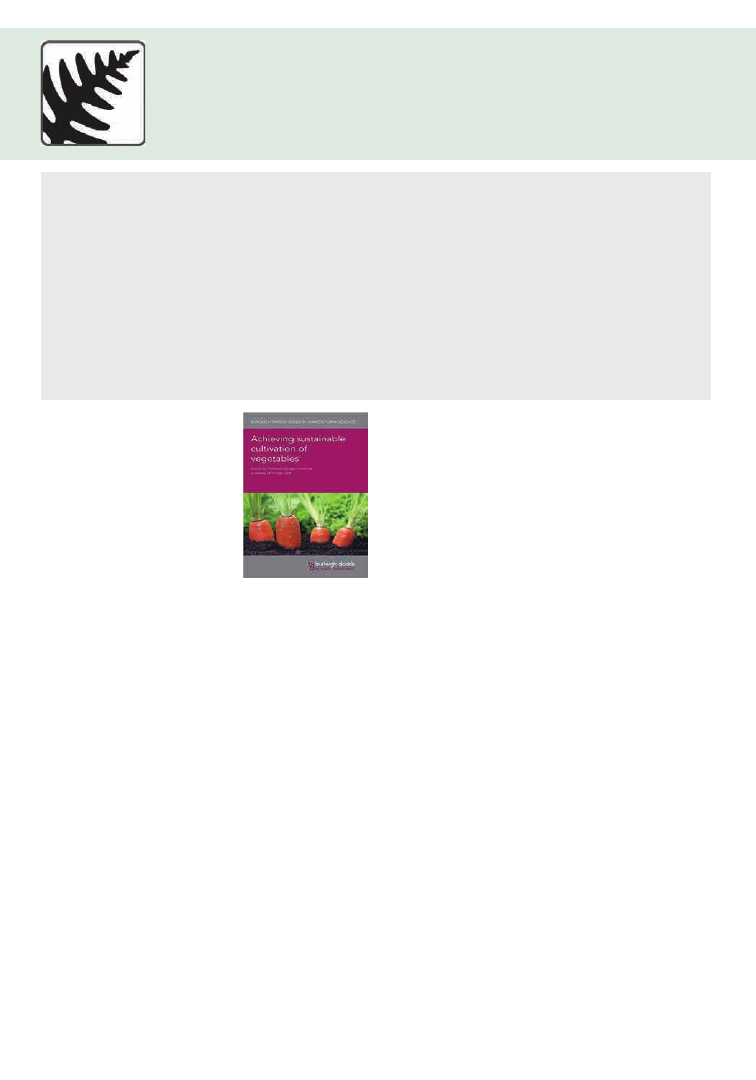
128
Achieving Sustainable Cultivation of Vegetables
Evolutionary Dynamics of Plant-Pathogen Interactions
Foraging for Survival. Edible Wild Plants of North America.
A History of Orchids in South America: Volume I – Colonial Times from Discovery
to Independence.
Lessons from Plants
Orchid Species from Himalaya and South East Asia Vol. 1 (A-E)
Plant Genetic Resources: A Review of Current Research and Future Needs
The Pomegranate: Botany, Production and Uses
Wild Orchids of the Southwestern United States. A Field and Study Guide.
BOOK REVIEWS
Achieving Sustainable
Cultivation of
Vegetables
George Hochmuth (ed.)
2019. ISBN: 9781786762368
£180 (hard cover); 644 pp.
Burleigh Dodds Science
Publishing
“Sustainability involves meeting current needs
without compromising the ability to meet
future requirements” (Hochmuth, p. xviii).
This opening remark of the Introduction to
Achieving Sustainable Cultivation of Vegetables
edited by Professor George Hochmuth,
University of Florida, USA, is not a flippant
observation as Hochmuth asserts that proper
(and successful) sustainable agricultural
practices make all the difference between
substantial crop yield versus utter loss in
impacting the environment, marketing, and/
or food justice in a locale. As a reviewer of
Hochmuth’s compilation, with consideration
of the time, effort, and work that went into his
book, I must caution the reader that I will not
do adequate justice to the research and insight
contained in this admirable book. I summarily
dissected the four main parts of the book to
provide an overview for each chapter.
The three chapters of Part 1: Physiology
and Breeding are divided to discuss root
physiology, abiotic stressors, and breeding
quality of plants. For Chapter 1: Advances
in Understanding Vegetable Physiology, is
a discussion of complex root frameworks
reaching for the water sources carrying
needed nutrients, the importance of xylem
vessel diameter, and the hydraulics for
transport of said water and nutrients. Chapter
2: Abiotic Stressor Influences includes any
external condition inflicted on the plant
through the air, soil, or water. These external
influences may dominate, alter, or destroy
functional cellular properties of a plant.
Thoroughly discussed in this chapter are
environmental conditions which hold sway
over successful plant metabolism affecting
crop production, economic fundamentals,
and foodstuff essentials. The 3rd chapter,
Developments in Breeding Vegetables,
reminds the reader (and researcher) that the
vegetable products from the veg fields of our
forefathers, with dimples and blemishes from
insect and pathogen damage, are considered
substandard by today’s consumers. There are
sections denoted to phenotype and genotype
strategies of genetic mapping, marker-assisted

PSB 67(2) 2021
129
and genome- selection/editing/engineering.
A case study focus with tomatoes, and another
with Brassica oleracea vegetables, continues
the comprehensive and erudite discussion of
genetics.
Cultivation is represented in Chapters 4
through 8 of Part 2 of this academic tome
and discusses the mediums for plant growth
including health and irrigation of soil,
greenhouse and hydroponic techniques, and
concludes with a chapter on advancements
in organic cultivation. Chapter 4: Advances
in Irrigation Techniques in Vegetable
Cultivation, discusses varied irrigation
systems such as sprinkler, drip, surface flood/
furrow, and subirrigation The mathematics
for determining soil moisture capacity are
explained in the latter half of this chapter.
Chapter 5: Advances in Understanding Soil
Health for Vegetable Cultivation, lends to
scientific discussions of soil quality, soil
properties, soil-borne diseases, and the
essential life-giving nature of what is soil, and
not dirt. Hochmuth echoes Aldo Leopold’s
extracted sentiment from A Sand County
Almanac (1949) that soil health is the land’s
capacity for self-renewal. It is the swapping of
an academic cap for one of philosophy that I
most admired in this fifth chapter.
The 6th chapter, Advances in Greenhouses
and Other Protected Structures Used for
Cultivation of Vegetables, begins with a
historical introduction of the origins of
sheltered gardens. The research presented
in Chapter 6 includes a comprehensive table
of the worldwide distribution of principle
production countries in greenhouse
cultivation. Hochmuth subsets include
detailed bio-management stratagems
including (in part) types of structures, location
considerations, climate management, soil and
soilless growing systems. The chapter is a topic
unto itself and is the longest in Hochmuth’s
book.
Hydroponic systems are expounded upon in
the 7th chapter, Developments in Soilless/
Hydroponic Cultivation of Vegetables.
Defined by the editor as “...any method of
growing plants without the use of soil as a
rooting medium, which involves supply of
all inorganic nutrients exclusively via the
irrigation water,” (Hochmuth, p. 211) this
chapter nicely supplements the previous
with greater detail into the developments,
advantages and disadvantages of hydroponic
gardening. Chapter 8, Advances in Organic
Cultivation of Vegetables, rounds off this
second section, Cultivation, of Hochmuth’s
volume. Use of manure and compost,
cover crop, and biostimulant substances are
part of this section on integrated nutrient
management. To his credit, Hochmuth
provides references and websites, even for the
omission discussions, to provide the reader-
researcher a complete intellection of progress
with organic cultivation of vegetables.
Part 3: Pests and Pathogens, include Chapters
9 to 12, as related to vegetable produce
and production, pathogen identification
technology, integrated pest management
(IPM) techniques, and finally with
microbiological sources including safety
and impact. Before the discussions of
pathogenicity in the serial chapters of the
third section, the apportionment that is
chapter 9, Understanding and Monitoring
diseases of Vegetables, is a quick-read
for those familiar with microscopic and
submicroscopic testing processes, and a quick-
reference for those who are not. One may get
a rudimentary understanding of what exactly
constitutes polymerase chain reaction (PCR),
microarray, DNA sequencing, enzyme-linked

PSB 67(2) 2021
130
immunosorbent assay (ELISA) and others.
Chapter 10: Advances in Understanding
Insect Pests of Vegetables: a Case-study of
the Sweetpotato Weevil is a unique chapter
in which Hochmuth, “...focusses on one
pest of one vegetable that advances greater
understanding of the sweetpotato and
[sweetpotato weevil] SPW…” which also has
parallel applications to other pests and their
veg of choice (Hochmuth, p. 293). The crops’
importance, and the SPW’s significance, are
detailed separately as the sweetpotato has far-
reaching roots around the world, particularly
in 3rd-World countries, with over forty
species of insect pests worldwide noshing
and destroying the plants from top to root.
Chapter 11: Integrated Pest Management
(IPM) in Vegetables: Examples of Successful
Deployment, and Chapter 12: Microbiological
Safety of Vegetable Produce: the Impact
of Pre- and Post-Harvest Practices, are
interesting precursors to the forthcoming Part
4: Case Studies. Both chapters are paired here
as they both shed light on the significance of
using multiple gardening strategies whether
the invader be macro- or microscopic. In the
aforementioned chapter, an IPM approach is
discussed through two case studies, selective
and individualized to the farm field, to
stave off pests. In the latter chapter, various
production methods and amendments, which
may be modes of deployment for curbing
microbial pathogens, are discussed. Organic
composts, irrigation water management, seed
contamination, cover crops, mulches, and
more are all conveyed with corresponding
references to current research and literature.
Part 4: Case Studies is a large section with a
representative crop for each chapter. The final
eight chapters (13 through 20) present an
inclusive discussion of breeding, production
practices, nutrient management, or pathogens
as warranted by the presented research.
Trends, challenges, conservation and nutrition
control are all included for improving said
breeding quality and production of each case
study chapter. The crops selected, in chapter
order, are carrot cultivars, lettuce varieties,
cucumber (Cucumis sativus) and watermelon
(Citrullus lanatus), and pea breeding (dry/field
pea, vegetable/green pea, and silage/grazing
pea). There are approximately 200 pages
of research information, article references,
and resources compiled here in Part 4 which
support the research and discussions of Parts 1,
2, and 3.
From the beginning of his book to its end,
it has been Hochmuth’s intent to address
and educate with a comprehensive synopsis
of what he calls “...the wealth of research
addressing these challenges...” (Hochmuth,
p. xviii) in sustainable growth of vegetables
with crop protection and cultivation, and
minimal destructive impactions from various
determinants. I believe he has succeeded.
-Karen Penders St. Clair, Ph. D.

PSB 67(2) 2021
131
Evolutionary Dynamics of
Plant-Pathogen Interac-
tions
Jeremy J. Burdon and
Anna-Liisa Laine
2019.
ISBN13: 978-1-108-62551-7
Paperback, US$49.99;
392 pp.
Cambridge University Press, Cambridge,
United Kingdom
Plant pathogens are ubiquitous and vastly
diverse. All parts of plants are vulnerable to
pathogens that may directly affect the vigor,
fecundity, and mortality of the host plant.
In Evolutionary Dynamics of Plant-Pathogen
Interactions, Dr. Jeremy Burdon and Dr. Anna-
Liisa Laine take readers through the history
and science surrounding plant-pathogen
interactions in hopes of enhancing interest in
and highlighting the importance of space and
time on the complex development and ever
evolving dynamics of pathogen relationships
with their host plants. The book is organized
into nine chapters, including an introductory
chapter, seven core chapters, and final chapter
with tips for future research.
In the first chapter, Burdon and Laine ease
the reader into the book with an introduction
on the basics of plant pathology. They take
the time to highlight some of the cases that
stimulated interest in the role of pathogens
as driving forces in evolution (e.g., role
of barberry eradication in controlling
wheat stem rust), and the importance of
invasive pathogen impacts on naïve hosts
(e.g., destruction of American chestnut by
Cryphonectria parasitica) to provide some
context on why plant pathogens are important.
Chapter Two discusses how the environment
determines pathogen incidence, abundance,
and evolution. For example, the chapter
addresses how temperature and precipitation
influence the abundance and incidence of
plant pathogens. The authors use variations of
the disease triangle to explain how seasonality
and other factors (e.g., microbiome) interact
with the plant genotype, pathogen genotype,
and environment to drive or limit disease
signs and symptoms.
The third chapter addresses the genetics
of pathogenicity and host plant resistance.
There are many means by which plants can
resist, escape/avoid, tolerate, or reduce the
aggressiveness of pathogens. The chapter
discusses the importance of the gene-for-gene
hypothesis and provides a very helpful table
with wild plant-pathogen associations that
involve putative gene-for-gene systems. Major
resistance genes, multiple minor resistance
genes, and adult plant resistance are also
discussed in depth with lots of information and
figures derived from peer-reviewed literature.
Chapter Four focuses on sources of variation
in plant pathogens, especially as it pertains
to aggressiveness and infectivity. The authors
aptly quote E.C. Stakman in saying that “plant
diseases are shifty enemies” before detailing
how different forms of recombination (e.g.,
sexual, asexual, intraspecific, interspecific,
viral), mutation, genetic drift, and gene
flow contribute to pathogen variation in
aggressiveness. Speciation is also addressed in
an interesting and thoughtful discussion on
cryptic species complexes.
The fifth chapter discusses the demographic
and genetic processes in pathogen and plant
host populations. Much of the book highlights
the extreme complexities surrounding plant-
pathogen complexes. However, this chapter
along with the sixth and seventh chapters
(which focus on the co-evolutionary dynamics
from the context of metapopulations and
plant-pathogen life histories, respectively)
really demonstrate the diversity of responses

PSB 67(2) 2021
132
possible with plants and their associated
pathogens. Specifically, Chapter Six
provides three examples of plant-pathogen
metapopulation studies—meadowsweet
(Filipendula ulmaria)-Triphragmium ulmariae
rust interactions in the Skeppsvik archipelago,
narrowleaf plantain (Plantago lanceolata)-
powdery mildew (Podosphaera plantaginis)
interactions in southwestern Finland,
and Australian flax (Linum marginale)-
Melampsora lini rust interactions in New South
Wales, Australia—that demonstrate the spatial
and temporal unpredictability of interactions.
The complexities of host and pathogen
life history traits (e.g., dispersal, infection,
lifestyle, mating system) are discussed in the
context of modeling in Chapter Seven.
The eighth chapter focuses on the effect of
pathogens on plant community dynamics,
and contains tables and a lot of fascinating
discussion around the effects of non-native,
invasive, and native plant diseases. Some
readers might find the section on the future
impact of diseases considering anthropogenic
change to be rather bleak, but thought
provoking at the same time. The final chapter
of the book focuses on knowledge gaps and
suggests ideas for future study, including
studies on the evolutionary dynamics of plant
resistance genes, impact of climate change
on epidemiological patterns, and effects of
invasive pathogens on plant community
structure. Burdon and Laine also provide a
few pages of glossary to help define some of
the scientific terms that are used throughout
the book. At the end, the extensive knowledge
summarized in the book is documented in a
70+-page reference list for those wanting to
learn more about the research contained in
each chapter.
There were only a few shortcomings of the
book. Of these, some were partially remedied
by other parts of the book. For example,
several chapters have grayscale images and
figures to illustrate some of the pathogen signs
and symptoms on plant hosts. Many of the
grayscale images do not have enough contrast
to see differences, but, fortunately, the pictures
are reproduced on color plates as an insert
in the center of the book. Additionally, the
content within the book can get quite dense,
understandably due to the extensive scientific
jargon associated with the overall topic.
This is partially remedied by the glossary at
the end, but not enough to make this book
suitable for a more general audience without
prior knowledge about plant pathology and
genetics. A final limitation of this book is that,
although the authors indicate that they address
“plant-pathogen interactions,” they base most
of their discussion around fungal pathogens
and oomycetes, not bacteria, viruses, and
nematodes. This limitation certainly does not
diminish the quality of the book; it just makes
the title seem somewhat misleading.
Overall, there are many positive things to say
about this book. In the back cover description,
Burdon and Laine express that a key goal
was to unite different disciplines that “have
largely kept themselves separate,” including
agriculture and forestry, conservation
biology, and genomics. They have certainly
accomplished this and, in the process, provided
a timely synthesis for any person that regularly
works with plant pathogens (in agricultural
or natural settings) and wants to learn more
about the ecological and evolutionary aspects
of plant-pathogen (fungi) interactions.
--A.N. Schulz, Department of Agricultural
Biology, Colorado State University, Ft. Col-
lins, Colorado, USA

PSB 67(2) 2021
133
Foraging for Survival:
Edible Wild Plants of
North America
Mykel Hawke and Douglas
Boudreau
2020. ISBN: 978-1-5107-3833-1
Paperback. $17.00; 195 + VII pp.
Skyhorse Publishing. New York,
New York
The title of this important contribution to
foraging wild edible plants is both accurate
and misleading—accurate because it provides
detailed information on survival plants; on
the other hand, misleading because the region
covered is not North America (despite the
statement that plants included occur “all over
the United States”.) Rather, the coverage is of
the Southeastern United States with a definite
subtropical and tropical Florida bias. The
book is apparently largely co-authored but
with some chapters under the name of either
Hawke or Boudreau.
Like the title, the arrangement of topics is
confusing. For example, Chapter One (“Special
Rules”) is a discussion of how to learn the
plants. There is a warning about poisonous
plants, a rational treatment of herbal remedies,
universal edibility testing, mushrooms,
seasonal considerations (something that
most guides do not include), and other good
information. Inexplicably, the final entry in
this chapter is a “tip from your uncle Myke”
describing the use of bleach for “poison
sumac” that inflicted him in California. To
my knowledge, poison sumac (Toxicodendron
vernix) does not occur in California although
T. diversilobum is common there and can
be a large shrub. (Despite the experience of
Uncle Myke, I would not recommend bleach
to clear up urticaria from any species of
Toxicodendron.)
Chapter Three is an excursus by Boudreau on
the warnings in Chapter One. It is wordy but
contains information any forager should know.
Accuracy of determination and warnings of
toxic plants continues the cautionary theme
based on the author’s personal experience.
Another example of the book’s quirky nature is
Chapter Five, which promotes entomophagy!
The bulk of the book is a treatment of more
than 200 plants, each with images of varying
quality and therefore limited utility. Harvesting
and preparing food from these plants is given
in detail. Reading these accounts, one feels
the authenticity of the information despite the
quirkiness. Most of the entries would be in any
treatment of edible plants of the Southeastern
United States though, as noted, many species
are not found outside Florida. Examples
include Coccinia grandis, Chrysobalamus [sic]
icaco, Paederia foetida, and Eugenia axillaris.
There are more. Oddly, there is an entry for
American cancer root (Conopholis americana)
but nothing about its use or why it is included.
The final chapters deal with poisonous plants,
medicinal plants, and “nibbles.”
Who should buy the book? It is a must for
survivalists, and anyone interested in foraging
in Florida. The attention to detail for species
common in the eastern United States gives
the work currency beyond the borders of the
Sunshine State. I regret I did not have this
volume before completing the manuscript of
our book on edible wild plants (Musselman
and Schafran, in press). Foraging for Survival
is a good deal at less than $20.
This is a book for serious foragers. It includes
warnings about poisoning, foraging ethics,
nutrition, methods of preparation, and
much more. Despite apparently limited
editing, inadequate images for many entries,
unnecessary repetition, botanical lassitude,
and digressions, I recommend this work as a

PSB 67(2) 2021
134
source for foragers and echo what is said in
the foreword: “Consider this book a resource
of good country knowledge. Learn, study,
build on and pass on this knowledge, as it is
sure to be useful.”
LITERATURE CITED
Musselman, L. J. and P. W. Schafran. Edible
Wild Plants of the Carolinas. A Forager’s Com-
panion. A Southern Gateways Guide. Chapel
Hill: University of North Carolina Press. In
press.
--Lytton John Musselman, Blackwater Ecologic
Preserve, Old Dominion University, Norfolk,
VA 23529-0266
A History of Orchids in
South America: Volume I
Colonial Times from
Discovery to
Independence
Carlos Offenbach
2020. ISBN: 9783946583240
£195.00 (hardcover); 626 pp.
Oberreifenberg (Germany);
Koeltz Botanical Books
This magnificently illustrated volume presents
a history of European botanical exploration
and collection that contributed to the
discovery of South American orchid species
from the 17th to early 19th centuries. It does
not consider orchid phylogeny or the history
of our understanding of their classification
or biology. The book consists of mini-
biographies of nearly 100 personages, each
typically followed by a list of orchid species
described from their collections and/or
named in their honor. Any orchid collections
they made outside South America, or any
plants other than orchids they collected on the
continent, are outside the scope of the book,
as the author repeatedly reminds us. Several
introductory pages on the colonial history
of the continent provide a backdrop for the
biographical sketches. It is interesting to note
how many of these early botanical explorers
were physicians by training, or ordained
priests, or men of title and leisure. And how
often their lifetime efforts ended in disastrous
loss of their collections, penury in old age,
death by tropical disease, or failure to ever
publish results! Nearly all the biographical
subjects are Europeans, and the perspective
throughout is understandably Eurocentric.
The reader feels the awe and excitement of
their encounters with unfamiliar landscapes
and biodiversity, and when the narrator tells
us who was “first” to navigate the full length
of a principal river, climb an Andean peak, or
resolve the question of whether the Orinoco
and Rio Negro tributaries interconnect, we
easily forget that such things were almost
certainly done and known previously by
indigenous Americans, who, of course, had
inhabited the continent for many thousands
of years prior to these recorded events.
Indeed, one cannot help wondering just how
much the native South Americans themselves
understood about their local biodiversity.
Did they recognize orchids—or epiphytes—
as a group, and to what extent did they have
names for different orchids? What might
they have known about orchid flowering and
interactions with insects and animals of the
community? Did anyone bother to ask them?
The biographies are treated in roughly
chronological order, but as lifetimes overlap,
the narrative skips back and forth in time,
leaving the attentive reader with chronological
whiplash. While there are many little details
that make a lasting impression, it is difficult to
keep track of the large number of individuals
covered in so many separate portraits, which
frequently share similarities. At times, the
reader gets the impression that individually
written biographies were assembled into
the present order without a reworking or

PSB 67(2) 2021
135
Regardless of any shortcomings, many
readers will be persuaded to acquire this
book if they are given the opportunity to leaf
through it. Nearly every page has excellent
quality color figures that include period
portraits of the collectors, explorers, and
relevant historical figures; contemporaneous
maps; landscapes painted by the European
artists documenting the New World; and, of
course, a considerable number of the original
botanical illustrations that accompanied the
orchid species discovered. This visual treasure
is highly effective in pulling the reader into
another time and place and makes a lasting
impression.
--William B. Sanders, Florida Gulf Coast
University
rereading of the narrative as a whole; some
details are repeated in a way that suggests
the narrator has forgotten what was said
previously, while elsewhere, persons who will
be portrayed only later on are referred to as
though the reader were already familiar with
them. One may regret the absence of a unified
narrative that might integrate the stories of
the more significant protagonists involved
and give a more critical perspective on the
events in which they participated.
Errors of typography and spelling are
unfortunately numerous. Most could have
been caught with conventional word-
processing software. Even a few orchid
terms are affected (sic: gymnostemium,
Bolbophyllum), and the continent’s largest
city, São Paulo, is everywhere misspelled, as
is another Brazilian toponym, Santa Catarina.
“Swainson” is alternatively spelled “Swanson”
so many times that one begins to wonder
if in fact they are two different people. A
number of dates are obviously erroneous:
Juan Pizarro founds the city of Lima in 1535
but also that of San Miguel de Piura in 1832,
and meets his death at the hands of Almagro’s
son in 1841; the period covered in the present
book is given in the first paragraph of the
introduction as 1848–1823, that of the 17th-
century Dutch colonization of Brazil as 1830–
1854, and a Franz Post landscape painting of
that period is dated 1838. Nor is it believable
that Jorge Juan’s measurement of the distance
corresponding to one degree of longitude
along the equator produced a figure of around
112,000,000 meters; this is three orders of
magnitude too large, and obviously many
times the circumference of the earth. It’s a
pity to see editing and proofreading neglected
when the author has done such prodigious
historical research, and the publisher has
assembled the work with otherwise superb
production standards.
Lessons from Plants
Beronda L. Montgomery
2021. ISBN-10: 0674241282;
ISBN-13: 978-0674241282
$22.95 (hardcover); 240 pages
Harvard University Press
The first thing that strikes
you is the beautiful cover of
the book and the overall attractive presentation
produced by Harvard University Press. Once
you start reading, you will find some wisdom
and life lessons for humans based on the study
of plant biology, physiology, and ecology.
As someone who studies plant tropisms, I
frequently start seminars with the comment
that plants cannot run away from adverse
conditions, but they can adjust to their
environment. So, we have the directed growth
in response to gravity (gravitropism) and light
(phototropism). Plants also can change their
physiology or morphology to deal with the
environment. The author uses broad themes in
plant physiology and biochemistry to provide
lessons for human behavior with a little bit of
anthropomorphism thrown in.

PSB 67(2) 2021
136
Dr. Beronda Montgomery is a Professor in the
Departments of Biochemistry & Molecular
Biology and in Microbiology & Molecular
Genetics at Michigan State University. Full
disclosure: I know her since we both share a
common interest in the role of phytochromes
in plant development (Hopkins and Kiss,
2012; Oh and Montgomery, 2017).
This short, easy-to-read book has six chapters
and a very extensive notes/bibliographic
section. The second chapter (“Friend or Foe”)
considers topics such as the effects of light
quality/quantity on plant development and the
important topic of mycorrhizal relationships
in plants. She calls these fungi “friendly”
microorganisms and, indeed, 90% of vascular
plant species have mycorrhizal associations
(Moora, 2014). The human lesson here is that
it is important for us to form wide-ranging
collaborative networks to be successful in life.
The chapter titled “Transformation” considers
ecological succession after a natural disaster.
Montgomery uses the recovery of the
landscape after the volcanic eruption at Mount
St. Helens as an example. Human leaders are
like pioneering plant species—they can help
forge new directions and innovations. Just
like in plant ecology, the transformational
pioneers may require a period of disruption
to make their mark.
In “Plan for Success”, the author shows how
plants care for themselves and engage with
other plants by budgeting energy and altering
their life cycle to meet the present conditions.
She asks if house plants do not thrive, do
humans consider it the fault of the plant?
The answer is no and that we will try to alter
the conditions for the plants so that they do
well. However, why do we place the blame on
a student if they are not doing well? Perhaps
we should consider that the support provided
does not meet the needs of the individual we
are trying to support. An interesting thought!
In some ways this book is in the genre of
books that provide insights into plant biology
to a broader audience. Two books that come
to mind are “What a Plant Knows” by Daniel
Chamovitz (2012) and “Plantwatching:
How Plants Remember, Tell Time, Form
Partnerships and More” by Malcolm Wilkins
(1998). Chamovitz gives insights into
major themes in plant sensory physiology
in a very accessible way, yet he provides
abundant scientific citations. Wilkins, who
has written specialist books, uses spectacular
photography to make important points about
plant physiology and development.
“Lessons from Plants” tries to take some of
these same themes and apply them more
broadly as models for human behavior. Dr.
Montgomery clearly provides insights into
her love of plants and is a very enthusiastic
author. The book, which is for both botanists
and a general audience, makes for a great gift,
and I noticed that many lab directors bought
these for their students this past year.
LITERATURE CITED
Chamovitz, D. 2012. What a Plant Knows: A
Field Guide to the Senses. Scientific American/
Farrar, Straus and Giroux, New York.
Hopkins, J. A., and J. Z. Kiss. 2012. Phototro-
pism and gravitropism in transgenic lines of
Arabidopsis altered in the phytochrome path-
way. Physiologia Plantarum 145: 461–473.
Moora, M. 2014. Mycorrhizal traits and plant
communities: perspectives for integration.
Journal of Vegetation Science 25: 1126-1132.
Oh, S., and B. L. Montgomery. 2017. Phyto-
chromes: Where to start? Cell 171: 1254-1256.

PSB 67(2) 2021
137
Wilkins, M. 1988. Plantwatching: How Plants
Remember, Tell Time, Form Partnerships and
More. Facts on File Publications, New York.
--John Z. Kiss, PhD, University of North
Carolina Greensboro, Greensboro, NC
Orchid Species from Hima-
laya and South East Asia
Vol. 1 (A-E)
Eng Soon Teoh
2021. ISBN: 978-3-030-58871-7
(hardcover); ISBN: 978-3-030-
58872-4 (ebook)
$219.99 (hardcover); 504 pp.
Springer Nature Switzerland
AG, Gewerbestrasse 11, 6330
Cham, Switzerland
A staggeringly large number of species are
native to the area covered by the first volume
(of three) of this work. If the numbers found in
every country or geographic area were added,
the total may well be in the many thousands.
In reality this is not the case, because many
species are widespread and can be found in
more than one country and/or area. Numbers
are changing constantly as new species are
discovered and/or as taxonomists split and/
or lump taxa. Regardless, the task Dr. Teoh
(a Singapore gynecologist by profession, an
accomplished orchid grower and scholar by
avocation, a talented photographer, a prolific
author of books about orchids in his spare
time, and a friend of nearly 50 years, who
provided me with a copy of the book) has
assigned to himself is brobdingnagian, even
if one considers only library searches and
writing the text. But this is not all Dr. Teoh
has done. An excellent photographer, he
photographed the orchids, which are described
in the book, in private collections, commercial
establishments, botanical gardens, and native
habitats. Living in Singapore, as he does, helps
because orchids abound there, but he also
traveled extensively.
Photographs are from one to several per
page. They vary in size from full (p. 76)
to quarter page (p. 453), or less (p. 259)
with many gradations (p. 403) in between.
The photographs display the orchids from
different perspectives, which present them
at their best. Included are images of plant
rows in a commercial orchid farm (e.g.,
Aranda Mak Chin On in Maryland Orchids
Company, Singapore, where I visited often
and resided for a while; p. 65), plants in full
bloom with many flowers or inflorescences
(Bulbophyllum lepidum on p. 129), entire
racemes (Bulbophyllum coniferum, p. 132),
individual flowers (Aranda hookeriana, p.
56), close-ups (Bulbophyllum grandiflorum
on p. 138 and Eulophia nuda on p. 489), and
plants in their natural habitats (a Vietnamese
Acriopsis on p. 16 and Dendrobium signatum
on p. 354). For orchids that have beautiful
leaves, the photographs show both foliage and
flowers (Anoectochilus brevilabris, p. 45). Also
included are drawings and paintings from rare
old books (Calanthe Dominyi, p. 172). To put
it simply, the book is profusely, beautifully,
and instructively illustrated. Only one
photograph does not meet the high standards
of the others. It is of Anthogonium gracile on p.
48. Most of it is black background, and details
of the orchid are lacking—and the hand that
holds the plant should have been removed. It
would have been easy to do with Photoshop.
A total of 491 species plus 13 botanical
varieties and 3 natural hybrids in 51 genera
are described in the book. The approach is
encyclopedic. Arrangement is alphabetical by
genus and within genera. Every genus has its
own numbered chapter and list of references.
Chapter lengths vary depending on the size
of each genus. For example, Calostylis and

PSB 67(2) 2021
138
Cephalanthera occupy two pages each (pp.
183-184 and pp. 185-186, respectively),
whereas Dendrobium is spread over 154
pages (pp. 293-447). Descriptions are short,
to the point, easy to read, clear, informative,
and never unnecessarily verbose. They
include information regarding geographical
distribution of a species, habitat, growth
habit, stems, leaves, inflorescences, and
flowers. Dimensions and size are included.
Herbal medicine uses, flowering seasons, life
span of flowers, and cultivation methods are
described for some species.
Every genus (i.e., chapter) has its own list of
references. Generally, I believe that books
should have a single Literature Cited or
References section for all chapters. This saves
space and avoids repetitions. In this case
separate references are necessary because
volumes will be published separately with
varying intervals between them.
The book also mentions and/or describes
61 cultivated hybrids. Some are old and well
known, such as Arachnis Maggie Oei (Arachnis
hookeriana × Arachnis flos-aeris), produced in
1950 by (Christopher) John Laycock (1887,
UK; 1960, Singapore)—a lawyer, an early
orchid grower in Singapore, and one of the
founders of the Malayan Orchid Society in
1928. He named the hybrid for his friend and
companion, Maggie Oei (when the hybrid
that bears her name became famous, an
unsuccessful effort was made to locate her). It
received consideration when a national flower
was being selected for Singapore, but Vanda
Miss Joaquim, which also has an interesting
history (Hew et al., 2002; Arditti and Hew,
2007) was chosen. Hybrids I never heard of
until now, and that have less exotic histories,
like Cymbidium Peter Pan (p. 283), are also
described or mentioned.
Another hybrid mentioned in the book
is Calanthe dominyi (originally Calanthe
dominii), the very first horticultural orchid
hybrid. Its history dates back to 1852 when a
gregarious surgeon, who tended to civic affairs
(he was elected as sheriff), and both humans
and circus animals, John Harris (1782-1855,
https://artuk.org/discover/artworks/john-
harris-17821855-surgeon-95524), suggested
to John Dominy (1826–1891, https://
en.wikipedia.org/wiki/John_Dominy), orchid
grower for the famous Veitch nursery, that
orchids can be cross-pollinated. Dominy made
a cross (Calanthe masuca × Calanthe triplicata)
and sowed the seeds “. . . on blocks of wood,
pieces of tree-fern stems, strips of cork [and]
upon . . . moss . . .” (horticultural orchid seed
germination was just being developed then).
At least some of the seeds germinated and a
number of seedlings grew to maturity. The
hybrid flowered in 1856. John Lindley (1799-
1865), the so-called “Father of Orchidology,”
named it for Dominy “. . . in order to put upon
permanent record the name of the first man
who succeeded in this operation . . . .” Lindley
also published a colored plate (number 5042)
in the Botanical Magazine, vol. 84, 1858 (there
is more to this story; for details see Arditti,
1984).
Paper quality is important for a book like this
one because text and illustrations must not
“bleed” from one side of the page to the other.
Fortunately, the publisher did decide to use
good glossy paper, which, even if not thick
and heavy, prevents “bleeding.” The book is
still heavy.
There are two indexes in the book, one for
species and a second for hybrids. This is well
and good, but such a monumental work also
requires a detailed general index (what if
someone wants to search for white flowered
species, orchids that flower in May, or taxa

PSB 67(2) 2021
139
found only in Papua New Guinea?). My hope
is that there will be a general index for all three
volumes when the last volume is published.
I also hope that page and chapter numbers
will be sequential (i.e., the first chapter in
volumes two will be numbered 53 and text
page numbers will start with 505). And, I
would like to see a colored, well-annotated
map of the world with the relevant areas and
countries outlined.
When completed, this will not be a mere
three-volume book about orchids. It will be an
excellent three-volume excellently illustrated
and very informative encyclopedia for an
orchid-rich part of the world. It should prove
to be very useful for, and of interest to, orchid
growers (amateur and commercial), botanists
in general, and individuals who simply enjoy
good photography of beautiful and interesting
flowers. The only real problem is the usual
Springer Verlag overpricing.
LITERATURE CITED
Arditti, J. 1984. An history of orchid hybrid-
ization, seed germination and tissue culture.
Botanical Journal of the Linnean Society of
London 89: 359-381.
Arditti, J., and C. S. Hew. 2007. The origin of
Vanda Miss Joaquim. In: K. M. Cameron, T.
Kull and J. Arditti (ed.). Orchid biology, re-
views and perspectives IX, pp. 261-309. The
New York Botanical Garden Press.
Hew, C. S., T. W. Yam, and J. Arditti. 2002.
Vanda Miss Joaquim. National University of
Singapore Press, Singapore.
--Joseph Arditti, Professor of Biology Emeritus,
Department of Developmental and Cell Biol-
ogy, University of California, Irvine, CA.
Plant Genetic Resources:
A Review of Current Re-
search and Future Needs
M. Ehsan Dulloo, Ed.
2021; ISBN-13: 9781786764515
£160.00, €190.00, $210.00
(hardcover) ebook 178924076X;
352 pp.
Burleigh Dodds Science Publish-
ing, Cambridge, UK
A revolution in the planning, design,
financing, and delivery infrastructure for
plant germplasm is urgently needed to meet
the acute needs of our warming world. As
we grapple with the challenge of sustainably
feeding an increasing population in the face of
harsh and unpredictable growing conditions,
the newly released book: Plant Genetic
Resources, presents results of a major global
assessment to prepare agricultural crops for
climate change.
Editor M. Ehsan Dulloo is eminently qualified,
having published widely on biodiversity and the
conservation of genetic resources, as Principal
Scientist at Biodiversity International and
CIAT, and co-Leader of the Genetic Diversity
Cluster in the CGIAR research program on
Roots, Tubers and Bananas. He previously
served as Senior Policy Officer, Plant Genetic
Resources, FAO. The authors of each chapter
are notable within the constellation of plant
germplasm conservation. One can find an
imprint of the pioneering role of Jack R.
Harlan within many chapters.
Organized into three sections—importance
and value of conservation and use of plant
genetic diversity, protecting plant genetic
diversity: in-situ and on-farm strategies, and
enhancing conservation and use of plant
genetic diversity—together the chapters
articulate the value and challenge of saving
seeds of crops and their wild relatives, since
the aim of gene banks is primarily to secure

PSB 67(2) 2021
140
germplasm for crop improvement, particularly
critical now, confronted with global heating.
The FAO established a Commission in 1983,
emphasizing the interdependence of nations
in both the responsibility of safeguarding
plant genetic resources (PGR) and the mutual
benefits of using them. Their objective was “to
ensure that PGR of economic and/or social
interest, particularly for agriculture, will be
explored, preserved, evaluated and made
available for plant breeding and scientific
purposes” (p. 7).
Admittedly, protection efforts are often shaped
by politics as well as science. Regulations and
practices that govern exchange of germplasm
to address broader global challenges such as
advancement of science and innovation are
not as successful as they could be, because
they fail to integrate the complexity of the
exchange environment. It is important to go
beyond a legalistic approach to exchange, to
look at the broader social context. Addressing
the “hot potato issue” of Access and Benefit
Sharing: “the more the development of
internationally agreed enabling environment
lags behind the pace of technological and
scientific advancements, the more polarizing
arguments fester, contrasting viewpoints
calcify, and the dimmer hopes grow for
leveraging these tools to attain sustainable
food systems” (p. 25).
This reader views the chapter titled “Improving
the global exchange of germplasm for crop
breeding,” by Selim Louafi (UMR AGAP Institut,
CIRAD, University of Montpellier, INRAE,
Institut Agro, Montpellier) and Eric Welch
(Arizona State University), as foundational.
International and national rules, regulations
and laws have established increasing levels
of control over access, exchange, and use
of PGR, but the proliferation of procedures
and obligations for monitoring transfers to
third parties with memoranda of agreement,
prior informed consent and material transfer
agreements have added complexities to the
exchange process with the consequence that
breeders and researchers can no longer act
according to their own set of preferred rules
and norms; these have increased transaction
costs (p. 84). There is a concise assessment of
the complexities of collaborations involving
PGR (pp. 87-92), including definitions
(e.g., “sustained relationship,” which would
be valuable required reading for anyone
preparing to conduct international fieldwork).
Having arrived at a destination, one may
encounter efforts to “add additional terms”
or conditions to collect or use germplasm in
an opportunistic environment. The chapter
offers “a renewed perspective on the issue of
germplasm exchange, describing the reasons
why facilitation of exchange cannot be
confined to a simple set of legal access rules”
by recognizing that difficulties arise from the
reconciliation of various institutional logics
(p. 96).
Another example of this sourcebook’s
usefulness is “Key steps in conservation and
use of PGR” by Nigel Maxted and Joana Brehm
(University of Birmingham), which reviews
the multitude of techniques for collation and
analysis of ecogeographic data, which can
be handy in preparation for fieldwork and
subsequent data analysis.
Printed in the United States on sturdy paper
stock, the hardcover copy will withstand long-
term handling well. There are a few minor
grammatical issues: spelling, agreement of
noun and verb tenses, to be more useful; the
book needs a more complete index. The key
phrase “Nagoya Protocols” is listed only once,
but in the chapters, it appears at least five
times.

PSB 67 (2) 2021
141
It is likely that Plant Genetic Resources will
become the essential methods manual to
facilitate their international exchange and
local dissemination, with its commendable
component of advocacy. It may well become
the standard reference for researchers
at universities, institutes, government
departments, and plant nursery facilities
for many years. It provides an indispensable
contribution as a handbook for plant
collectors, with proposals about conservation
and use, from data management to strategies.
–Dorothea Bedigian, Research Associate, Mis-
souri Botanical Garden, St. Louis, Missouri,
USA
The Pomegranate: Botany,
Production and Uses
Ali Sarkhosh, Alimohammad M.
Yavari, �Zabihollah Zamani, Eds.
2020. ISBN: 9781789240764
Hardcover, £160.00, €185.00,
$215.00; ebook 178924076X.
584 pp.
Commonwealth Agriculture
Bureau International Books,
London
Pomegranate is an outstanding encyclopedic
handbook, the first comprehensive monograph
offering perspectives on issues related to its
botany, production, processing, health, and
industrial use. Its 100 contributors represent
12 countries: Afghanistan, Azerbaijan, China,
Egypt, France, Germany, India, Iran, Italy,
Spain, Turkey, and the United States.
Included is information about cultivation and
how to increase yields and profits; practices to
mitigate pests, diseases, abiotic stresses; plant
nutrition management; approaches addressing
earliness, yield, improved taste, soft seeds,
disease resistance, splitting and sunscald
rates; taxonomy and physiology; increasing
genetic diversity to improve crop security; and
nutritional composition and medicinal uses.
Punica granatum L. is among the earliest known
edible fruits. Appealing most to this reader’s
ethnobotanical interests is “Archaeology,
History and Symbolism”, including a photo
montage combining a Persepolis wall relief
showing a hand holding a pomegranate
flower, with a true-to-life example. To
these they could add the photograph of an
unearthed pomegranate flower from the
excavations of fortress Karmir-Blur (VII
BC) near Yerevan, Armenia (Stepanyan,
2007). Striking photographs of magnificent
gold charms show impeccably rendered
pomegranates festooning gold necklaces and
earrings, from excavations in Iran. To the
authors’ derivations of the linguistic origins
of the term pomegranate from Sumerian nu-
urma and Akkadian nurmu to Persian nar,
one could include Armenian
Նուր
, nurr.
Reading “Production and Growing Regions”, it
was surprising that the authors cited outdated
production data (Holland et al., 2009), until
discovering that FAOSTAT offers no coverage
about pomegranate production!
Broadening “Biodiversity, Germplasm
Resources and Breeding Methods”, Baer’s
(2007) letter to The New Yorker, in connection
with seeds and crops lost during Afghanistan’s
wars, offers another connection between
Afghanistan’s lost heritage and the importance
of gene bank seed repositories. Beginning
in the 1930s, Harold Olmo, a California
horticulturalist / plant explorer, traveled to
Afghanistan to collect regional cultivars for a
station at Davis, CA. His seeds and cuttings
were saved, propagated, and bred into varieties
of fruits and nuts consumed today. In 2003, a
delegation of Afghan horticulturalists arrived
at the USDA/ARS facility on the UC Davis
campus, where they rediscovered fruit- and
nut-bearing trees that have since been lost
in their country. Horticulturalists are now

PSB 67 (2) 2021
142
attempting to replant the denuded hillsides of
Afghanistan with offspring bred from crops
Olmo saved 70 years ago.
Although “World Pomegranate Cultivars”
omits Armenia, Chandra et al. (2010) indicate
that it was grown in 7 districts besides the Ararat
plain, in 52 of its 60 regions. Hovhannissyan
et al. (2014) refer to the Armenian cultivar
Gyulosha, and F.M. Harutyunyan, Head
Winemaker, Maran Winery (pers. comm.
via S. Tashjian, March 1, 2021) names strictly
Armenian cultivars, Gyulosha, Gyulosha pink
and Shahnar / Meghri golden.
“Pomegranate Bioactive Compounds and
Health” examines constituents effective
in fighting disease and slowing aging.
Pomegranates may help combat cancer
and hardening of the arteries. Antioxidant
flavonoids with beneficial effects are found at
high concentrations in pomegranate peel.
This subject appeals for several reasons:
its delicious and nutritious fruit; and how
pomegranate awakens memories, appearing in
art, folklore, and cuisine throughout historic
Armenia. Consequently, pomegranate was
adopted as a national emblem often used at
Armenian celebrations.
Unfortunately, the fruit with which Armenians
identify so strongly is conspicuously absent
from these pages. Within Armenian culture,
the pomegranate has long represented
fertility, abundance, and good fortune;
paintings and ceramic, metal, wood, and
textile pomegranates are ever-present.
At weddings in Western Armenia, it was
customary for a bride to throw a pomegranate
against a wall, to shatter it; its scattered seeds
ensured the bride future children. In Van,
Armenian women wishing to bear a son,
ate bread baked with pomegranate seeds. At
the culmination of weddings in Yerevan, a
small, dried pomegranate called taratosik
is given by the bride to unmarried guests
as a blessing (Petrosian and Underwood,
2006). Pomegranate is viewed as an amulet,
protecting people from the evil eye (Petrosian
and Underwood 2006) against bad spirits or
ill intentions.
Pomegranate has been used as an archetypal
ornament found on numerous historical
Armenian manuscripts; in religious art,
pomegranate appears on sculptured relief
friezes adorning the Cathedral of the Holy
Cross, Aghtamar Island in Lake Van, Western
Armenia, erected 915-921 AD. A film about
poet, musician, and bard Sayat Nova, born
Harutyun Sayatyan (1712-1795), repeats
those images on a coat worn by the actor
representing the father of the bride.
Among the most iconic Armenian art
films is Sergei Paradjanov’s “The Color
of Pomegranates”, a biography of Sayat-
Nova (King of Song) that attempts to reveal
the poet›s life metaphorically. A symbolic
scene shows a red pomegranate on a table,
its skin wrinkled, standing out against fresh
pulp, as an embodiment of the strength of the
Armenian spirit, its invincible soul. After the
horrific Armenian Genocide, many Armenian
artists have used pomegranates in their lyrics
and poems to describe a range of emotions,
from suffering to hope, rebirth and national
survival. The search term pomegranate in
ProQuest® Newspapers found an article in
the New York Times titled “Pomegranate as
Fruit of a Vintner’s Labor” about pomegranate
wine from Armenia, linked to numerous news
articles about the Ottoman-era Armenian
Genocide, beginning in 1894.
Colleague S. Martiros (pers. comm., May 25,
2021) describes a celebration that he heard
about from director, screenwriter, writer, and

PSB 67 (2) 2021
143
friend of Parajanov, Rustam Ibragimbekov,
during Parajanov’s 60th birthday at his
birthplace, Tbilisi. The courtyard was covered
with planks on which guests stepped as they
entered. Under the boards were pomegranate
fruits. As the guests stepped on the boards,
the fruits’ juice was expressed; that liquid was
collected in a vat through special grooves.
Later, guests were treated to this juice.
Subsequently, Ibragimbekov was subjected to
persecution in Azerbaijan and was expelled by
deputies when they discovered his bond with
Armenia.
In William Saroyan’s short story “The
Pomegranate Trees” (1937), the narrator’s
Armenian uncle bought large tracts of infertile
land in central California hoping to plant an
orchard of pomegranate trees. Unfortunately,
he could not sell the few fruits produced on
that desert soil; the buyer in Chicago did not
even know what pomegranates were, but
these cherished fruits, deeply entrenched in
memory, served as a transitional bridge for
the immigrant.
Pomegranate is so inextricably woven with
Armenia that a children’s book, “Hagop and
the Hairy Giant” (White, 2011), the Armenian
version of Jack and the Beanstalk, is set in
Masis, Armenia, where the hero Hagop scales
a magic pomegranate tree to rescue the lovely
Maryam, a prisoner of Medz Mazod, the
hairy giant. Hagop goes head-to-head with
Medz Mazod, battling him with a kebab shish,
leading to other adventures with the giant’s
magic oud and golden hen.
The importance of pomegranate is also found
in a traditional ending for Armenian fairy tales
(Petrosian and Underwood, 2006): “Three
pomegranates fell down from heaven: One for
the storyteller, one for the listener, and one for
the whole world”.
Particularly in this age of climate change,
pomegranate is a drought-resistant, salinity-
tolerant pivotal fruit that deserves more
scholarly attention, especially for regions
where agriculture is threatened by those
factors. Pomegranate should be the
standard textbook for horticultural research
institutes, libraries, government agriculture
departments, and plant nurseries. It provides a
dense consolidation of relevant topics that can
provide the field with valuable guidance as a
manual for growers, displacing a previously
reviewed attempt (Seeram et al., 2006). It is
well-illustrated, showing stages of flower
and fruit development, plant habit, various
approaches to pruning. The bibliographies
are substantial; the editors did their subject
justice. Ignoring occasional typographical
errors, and duplicate citations inserted out of
order (pp. 501-503), the well-bound volume
should enjoy long use as a reference work.
LITERATURE CITED
Baer, B. L. 2007. Seed Savers. The Mail, The New
Yorker Sept 7, 2007, p. 42.
Chandra, R., K. D. Babu, V. T. Jadhav, and J. A. Teix-
eira da Silva. 2010. Origin, history and domestication
of pomegranate. Fruit, Vegetable and Cereal Science
and Biotechnology. Global Science Books.
Holland, D., K. Hatib, and I. Bar-Ya’akov. 2009. Pome-
granate: botany, horticulture, breeding. In: J. Janick,
Ed. Horticultural Reviews 35: 127-191.
Hovhannissyan, H., S. Lertwatanakiat, and P. Sripinta.
2014. Study of the adaptability and growth of Arme-
nian fruit tree cultivars in Thailand. Acta Horticulturae
1059: 67-70.
Petrosian, I., and D. Underwood. 2006. Armenian
Food: Fact, Fiction & Folklore. Yerkir Publishing,
Bloomington, IN (pp. 238-239).
Saroyan W. 1937. The Pomegranate Trees. In: My
Name is Aram, pp. 33-55. Harcourt, Brace & World,
Inc., NY.
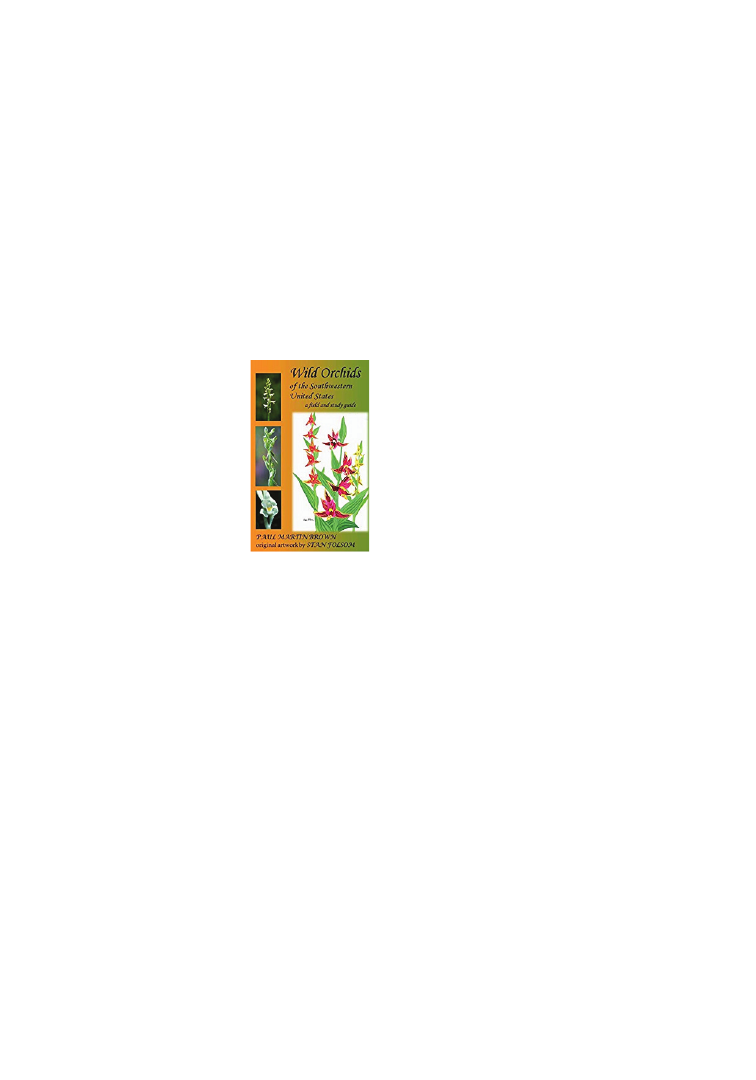
PSB 67 (2) 2021
144
Seeram, N. P., R. N. Schulman, and D. Heber (Eds).
2006. Pomegranates, Ancient Roots to Modern Medi-
cine. CRC Press, Taylor & Francis Group, Boca Raton,
FL.
Stepanyan N. 2007. Armenian wild pomegranate: A
rare and relic fruit. Bioversity Newsletter for Europe
34: 34.
White, T. D. 2011. Hagop and the Hairy Giant. TDW
Publishing.
–Dorothea Bedigian, Research Associate, Mis-
souri Botanical Garden, St. Louis, Missouri,
USA
Wild Orchids of the
Southwestern United
States: a Field and Study
Guide
P. M. Brown, with original art-
work by S. Folsom
2019. ISBN 978-3-946583-21-9
$70.00 (hard cover); 312 pp.
Koeltz Botanical Books,
Heftricher Str. 1, 61479
Germany
Approximately 250 orchid species are native
to the United States (9,834,185 km
2
), and
about half of them are in Florida (168 km
2
).
This book covers species found in Arizona (29
species and varieties in 293 km
2
), California
(39; 423,963 km
2
), Colorado (30; 269 km
2
),
Nevada (16; 285 km
2
), New Mexico (32; 313
km
2
), and Utah (25; 220 km
2
). Of these, 6
species occur in all of these states and 29 are
found in one state only.
The number of species per area in the United
States is remarkably small when compared to
Colombia (4270 species in 1,141,748 km
2
) or
Malaysia (4000 species in 329,613 km
2
), for
example. Colombia with an area 8.6 times
smaller than the United States has 17 times
as many orchid species. For Malaysia these
numbers are 30 and 16, respectively. Many
of the orchids in Colombia and Malaysia are
spectacular, whereas only very few American
species attract attention by others than those
interested in orchids.
This paucity of native species and the small
proportion of those bearing attractive flowers
are two reasons for the relatively small number
of books on American native orchids. Other
reasons are difficulties in (1) germinating their
seeds (we tried in my laboratories years ago
with limited success; recent efforts have been
more successful), and (2) cultivating many
of them despite a few successes. The authors
of this book and a few others (referenced in
this book) are among the small number of
botanists and growers who have paid and/or
are paying attention to at least some North
American orchid species (not referenced in
this book; for one list of horticultural sources
for some species please see http://botanyboy.
org/where-to-buy-lady-slipper-orchids-
online-north-american-sources/, although a
Google search should find more).
Despite its modest subtitle and relatively
few pages, this book is much more than just
a guide. It is more of a tightly and carefully
written and well-organized, concise, reference
work.
In Part One, two introductory sections set the
tone of the book: one is about orchids in the
southwest and the second deals with orchids
in general. They are useful, but I think that
their order should have been reversed; first
introduce orchids, and then discuss them
geographically. What seems to be a workable
and useful key (I did not try to use it) to
genera (keys to species are included in the
descriptions of genera) follows. The key is
followed by discussion of plant names. This
discussion should have preceded the key, but
this comment, like my previous remark about
the order of sections is a matter of opinion.

PSB 67 (2) 2021
145
The illustrations in the book are its major
problem. Some of the line drawings, color
photographs, and paintings are somewhat
useful, maybe passable, and perhaps even
good. Many convey only a general impression
at best. A few are confusing and of not much
use. At least one line drawing (p. 6), one
painting (p. 70), and one photograph (upper
left on p. 81) are not useful at all. I mention
one bad example for every type of illustration
in the book, but there are more. Good digital
cameras, excellent macro lenses, and very
good illuminators for close-ups (flash or LED)
are inexpensive and easy to use even under
field conditions. Programs like Photoshop
make possible production of good, attractive,
and instructive illustrations and layouts.
Photographic tools such as these leave no
excuse for what is presented as illustrations in
this book.
This book is valuable not only because books
on native American orchids are not common,
but also due to its excellent content. This is
exactly the kind of guide needed by those who
want to see and/or photograph southwestern
U.S. native orchids in their natural habitats. If
not as a guide for orchid hunting, this book
is an excellent source of valuable information
for botanists in general and those interested in
orchids in particular, and it will make readers
realize that there are many interesting, even
if not always gorgeous, orchids in the United
States.
-Joseph Arditti, Professor of Biology Emeritus,
Department of Developmental and Cell Biol-
ogy, University of California, Irvine.
The second part (pp. 17-196) consists
of descriptions of all native orchids (in
alphabetical order) in the southwest. The
first genus in the descriptions section is
the circumpolar Calypso, which is found
in America, Europe; and Asia; despite its
small flowers (2-4 cm) it is “one of the most
sought-after and most delightful of all
native orchids . . .” True, and a good start!
Descriptions are detailed and include clear
narrative, dimensions and line drawings,
color photographs and sometimes paintings,
distribution maps, and flowering period. All
descriptions follow the same format, are well
written, easy to read, and very informative.
They are a good example of what such
descriptions should be.
Part Three is what makes this book a good
and concise reference work rather than only
a guide. It contains checklists of orchids
for the southwestern United States and the
six states in it; regional statistics; a list of
rare, threatened, and endangered species;
recent literature references; synonyms and
misapplied names; and much additional and
very useful information.
The fourth part is all about orchid hunting.
It tells readers when, where, and how to find
orchids in the southwest. The information
in this part should make it easy to find and
enjoy native orchid in the southwestern
United States. Those who will hunt orchids
should do it with their eyes and cameras only.
Native orchids must not be touched and never
collected.
Several appendices are included in the
fifth part: distribution of species in the six
southwestern states, a table of flowering times,
an extensive bibliography, a list of new hybrids
and nomenclatural combinations, photo
credits, and a good, detailed index.
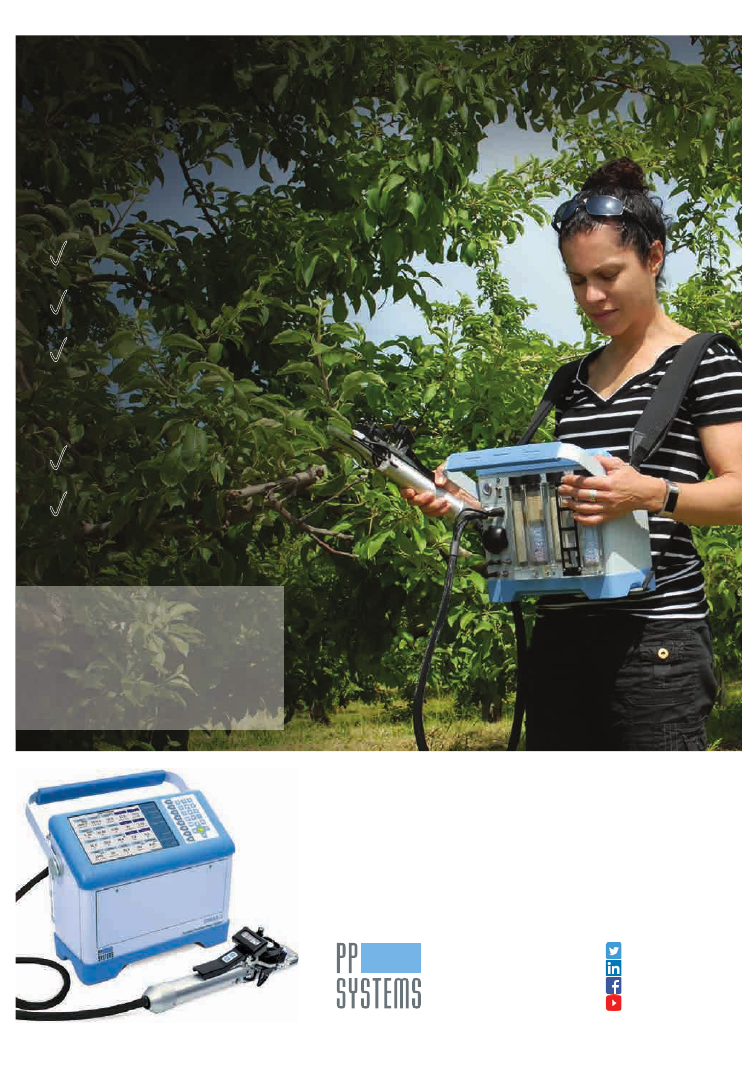
110 Haverhill Road, Suite 301
|
Amesbury, MA 01913 U.S.A.
|
+1 978.834.0505
|
sales@ppsystems.com
|
ppsystems.com
Elevate your research with the fastest,
most accurate portable leaf gas exchange
system available.
Measurements in seconds
Lightweight & compact
Simultaneous photosynthesis
& chlorophyll fluorescence
measurement
Ultrafast A/C
i
curves
Small system volume
advantage
•
Photosynthesis
•
Chlorophyll Fluorescence
•
Soil Respiration
•
Canopy Assimilation
•
Insect Respiration
;@pp_systems
company/pp-systems
ppsystems.intl
ppsystemsinc
CIRAS-3 Portable Photosynthesis System
Redefining the high-level research experience worldwide.

Plant Science Bulletin
The Botanical Society of
America is a membership soci-
ety whose mission is to: pro-
mote botany, the field of basic
science dealing with the study
& inquiry into the form, func-
tion, development, diversity,
reproduction, evolution, & uses
of plants & their interactions
within the biosphere.
ISSN 0032-0919
Published 3 times a year by
Botanical Society of America, Inc.
4475 Castleman Avenue
St. Louis, MO 63166-0299
Periodicals postage is paid at
St. Louis, MO & additional
mailing offices.
POSTMASTER:
Send address changes to:
Botanical Society of America
Business Office
P.O. Box 299
St. Louis, MO 63166-0299
bsa-manager@botany.org
The yearly subscription rate
of $15 is included
in the membership
Address Editorial Matters (only) to:
Mackenzie Taylor, Editor
Department of Biology
Creighton University
2500 California Plaza
Omaha, NE 68178
Phone 402-280-2157
psb@botany.org
Plant Science Bulletin
Summer 2021 Volume 67 Number 2
Wanda Lovan
is Retiring:
An
Appreciation
of her 18 Years
with the BSA
It is with heartfelt gratitude that we acknowledge the contribution of
Wanda Lovan to the BSA on the occasion of her retirement on July 16,
2021. Wanda began as an Administrative Coordinator at the BSA in
2003, when the BSA’s first Executive Director, Bill Dahl, established the
headquarters of the BSA at the Missouri Botanical Garden in St. Louis.
(This was at the invitation of then-Garden President, and former BSA
President, Peter Raven.)
Wanda came to the BSA after a 12-year stint with the Missouri Field
Office of The Nature Conservancy, where she went from part-time
secretary to Director of Operations. At the BSA, Wanda initially
managed membership and subscription services for the BSA and the
American Journal of Botany. Over the years, her responsibilities grew,
and the Society members and staff have grown and thrived under her
care and attention. She kept the 3000-plus members happy and the
books in order—and ultimately coordinated 10 staff members in 4
different locations, from California to New York.
Wanda's current title is Director of Finance & Administration. She has
expertly handled accounting responsibilities for grant funding from
NSF and management services provided to the Society for Economic
Botany, the Society for the Study of Evolution, and the American Fern
Society.
In addition to her many achievements for the Society, Wanda is an
enthusiastic supporter of the Missouri Botanical Garden and an avid
gardener in her own right. She is known for her unique way with
words (in poetry and conversation!), her enjoyment of being active,
her pleasure in wine tasting, and her overall positive outlook. We wish
her all the best in her retirement!
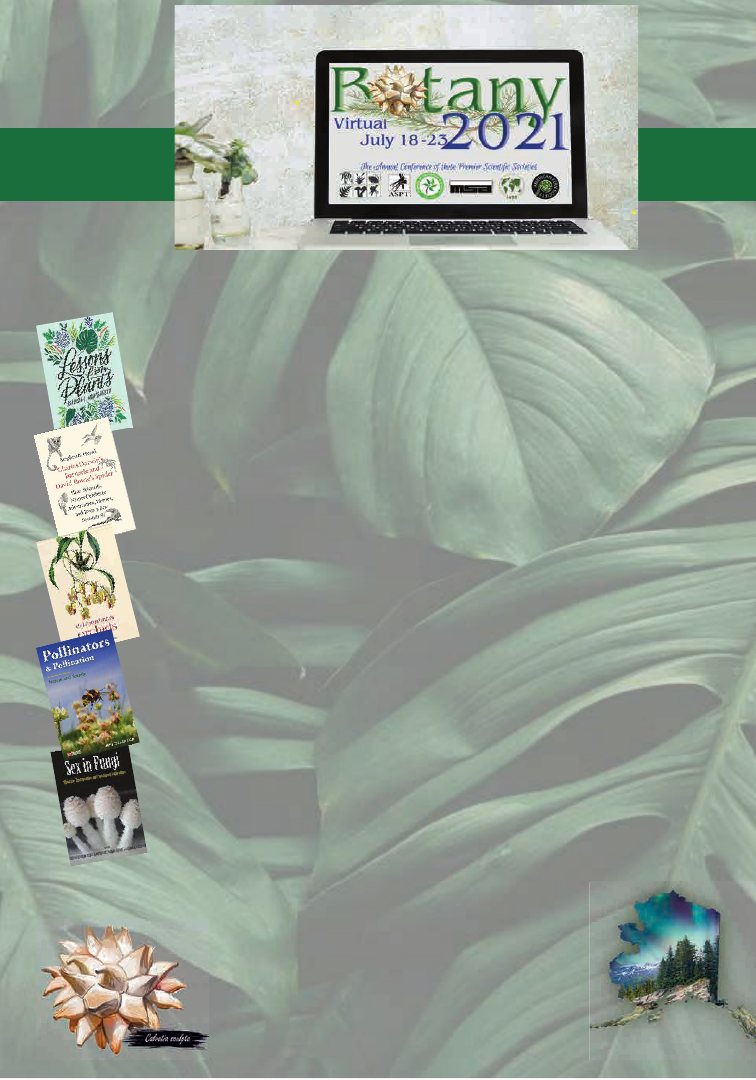
PSB 67 (2) 2021
148
Register Now!
botanyconference.org
Over 1100 Scientific Presentations!
Nine Special Lectures by
Prominent Scientists
Six full days of Workshops, Symposia and
Colloquia and Special Events
Botanical Drawing Lessions,
CV Reviews. Networking Receptions,
Botany Trivia
Special Joint Event with
Botany 2021 - Virtual! &
ASPB’s PB21 Plant Biology Worldwide Summit
Register Now!
botanyconference.org
Author Chats
Get ready for Botany 2022 Join the virtual race
around Anchorage! See the sights - Details Soon!